#77 is also Bach
Text
Cello-playing climate activist arrested at New York Citibank protest as crackdown escalates
Second activist also arrested during ‘summer of heat’ protest against second largest financier of fossil fuels
John Mark Rozendaal, an adjunct music instructor at Princeton university and Alec Connon, director of the climate nonprofit group Stop the Money Pipeline, were arrested for criminal contempt in the public park at the bank’s global headquarters as the crackdown against nonviolent climate protesters escalates.
Rozendaal was handcuffed and led away to the police vehicle singing “we are not afraid, we are not afraid, we will sing for liberation because we know why we were made”. The crowd of protesters chanted “let him play” and “ shame on you Citibank”.
Thirteen other climate activists, who had linked arms in a circle around Rozendaal to protect him as he played Bach’s suites for cello, were detained for alleged obstruction of governmental administration, a misdemeanor criminal charge. “People are dying … today is my birthday,” said Mike Bucci, 77, teary eyed as the police in riot gear broke up the protest.
Since 10 June, climate activists have been peacefully protesting against Citibank’s record financial support for new fossil fuel projects as part of the Summer of Heat on Wall Street campaign. At least 3,700 people have participated in the nonviolent civil disobedience, repeatedly blockading the entrance to its global headquarters. More than 475 people including faith leaders, scientists and elders have been arrested while calling on Citi to stop bankrolling new coal, oil and gas.
[...]
In a separate incident on 21 July, videographer and summer of heat organizer Teddy Ogborn was arrested and held in a cell for more than eight hours, days after he filmed an alleged Citi employee apparently inciting violence against climate protesters blocking the entrance.
“Just punch him in the f–king head! Punch him in the f–king head,” shouted the woman, identified by protesters as the executive assistant to Citi’s co-head of Global Financial Strategy, which Ogborn caught on camera. “Get a machine gun and f–king kill them all,” she added.
[...]
“We have made the bank synonymous with environmental destruction, violence and fossil fuels, and I have been capturing moments that are damaging for Citi,” said Ogborn, cofounder of Planet over Profits. “The escalation against organizers is targeted, and attempts to use bogus charges to harass and intimidate protesters.”
3 notes
·
View notes
Text
aight so here we go. as requested by popular demand:
the cryptid classical music list - pt. 1: what
just a quick warning: most of these will be pieces in the "contemporary classical" genre, which means there will most likely be a lot of dissonance. and also most of it is just weird.
also tumblr has an audio limit, so im splitting this into multiple different posts
alright lets get this list started.
Alfred Schnittke - Concerto Grosso No. 1
I - Preludio
II - Tocatta
III - Recitativo
IV - Cadenza
V - Rondo
VI - Postludio
And starting off strong, we have Schnittke's Concerto Grosso No. 1.
It's an interesting work because if you analyze the structure, it's very similar to a baroque-era concerto. The instrumentation is also very similar, consisting of two violin soloists, string orchestra, and harpsichord. The only difference is the addition of a prepared piano (which is a piano where stuff has been put between the strings in order to give it a different sound).
However, the piece itself is very modern. There are a few execptions, specifically the beginning of the Tocatta and various places throughout the Rondo.
This is a very eldritch-horror-esque piece due to its use of Ligeti-esque micro-polyphony. What Schnittke does is he takes each induvidual section of instruments and splits it up, similar to divisi. However, he subdivides it into 8 or 12 parts instead of a more normal two or three, leading to a very dissonant and unique sound.
Honestly, if you want to start listening to this, listen to the Rondo first; it's the most accessible movement in my opinion, but whatever order you take this in is up to you.
Performance provided:
Soloists: Gidon Kremer, Tatiana Grindenko
Orchestra: Chamber Orchestra of Europe, cond. Heinrich Schiff
----------
Krzysztof Penderecki - St. Luke Passion
Part I:
O Crux ave
Et egressus
Deus meus
Domine, qui habitabit
Adhuc eo loquente
Ierusalem
Ut quid, Domine
Comprehendentes autem eum
Iudica me, Deus
Et viri, qui tenebant illum
Ierusalem
Misere me, Deus
Et surgens omnis
Part II:
Et in pulverem
Et baiulans sibi crucem
Popule meus
Ibi crucifixerunt eum
Crux fidelis
Dividentes mero
... in pulverem mortis
Et stabat populus
Unus autem
Stabant autem iuxta crucem
Stabat mater
Erat autem fere hora sexta
[Alla breve]
In pulverem mortis/In te, Domine, speravi
[side note: i was typing the above on my phone and it took like twenty minutes ::( ]
So. Penderecki's St. Luke Passion. Where do we begin?
The St. Luke Passion is an interesting one, because out of all the gospels Penderecki could have chosen, he picked the one that Bach never made into a passion. And the references don't stop there, whether it be the use of a baritone to represent Jesus, or the B-A-C-H (Bb-A-C-B) motif.
The work is totally atonal, and there are a lot of jumpscares. Like a lot. The music is also incredible, and its use of timbre is incredible. (listen to the "Et surgens omnis")
In addition, Penderecki makes great use of the choir, using them for vocal effects alongside singing (listen to the "Popule meus").
Performance provided:
Soloists: Izabella Klosińska (soprano), Adam Kruszewzki (baritone), Romuald Tesarowicz (bass), Krzysztof Kolberger (Narrator/"Evangelist")
Choir: Warsaw National Philharmonic Choir, Warsaw Boys' Choir
Orchestra: Warsaw National Philharmonic Orchestra, cond. Antoni Wit
youtube
Link to Spotify Album
----------
George Crumb - Black Angels: 13 Images from the Dark Land
I - Departure
1 - Threnody I: Night of the Electric Insects
2 - Sounds of Bones and Flutes
3 - Lost Bells
4 - Devil-music
5 - Danse Macabre
II - Absence
6 - Pavana Lachrymae (Der Tod und das Mädchen)
7 - Threnody II: Black Angels!
8 - Sarabanda de la Muerte Oscura
9 - Lost Bells (Echo)
III - Return
10 - God-music
11 - Ancient Voices
12 - Ancient Voices (Echo)
13 - Threnody III: Night of the Electric Insects
Okay, do you remember what I said at the top about the music getting weird? Well this is peak weird.
Black Angels is written for string quartet with a few interesting modifications. The score requires you to use electric instruments, which are a weird choice. In addition, the score calls for each player to also use a series of percussion instruments and their voice in addition to playing their instrument.
And there are the avant-garde aspects of this as well. Every modern playing technique in the book is used in this, such as playing on the wrong side of the fingerboard, applying large amounts of pressure to the bow, bowing behind the bridge, and plenty more.
I'm gonna be entirely honest: this music sparks a weird reaction. If I try to listen to it as background music, it makes me dissociate a solid 80% of the time. So apporach at your own risk.
Oh yeah, and also there are a lot of jumpscares.
Performace Provided:
Miró Quartet
Daniel Ching (vln), Sandy Yamamoto (vln), John Largess (vle), Joshua Gindele (vcl)
youtube
----------
Alexander Scriabin - Piano Sonata No. 5 in F# Major (Op. 53)
Okay, we're finally venturing back into more tonal territory. And we're coming back with my favourite lunatic composer of all time: Alexander Scriabin.
I'll talk about him a little bit later along the list cause I have a better piece to reference, but for now just know that he once tried to end the world with music. Anyways, back to the sonata.
The 5th Piano Sonata is in one movement and spans a lot of keys. It contains some really pretty moments, as well as some moments that make you feel a bit overwhelmed. It's also very hard. But nontheless, it's still an amazing piece, and much more accessible than his later works.
Performance Provided: Sviatoslav Richter (pfte)
youtube
----------
Alberto Ginastera - Concerto for Harp and Orchestra (Op. 25)
I - Allegro giusto
II - Molto moderato
III - Liberamente capriccioso - Vivace
i'm just gonna be entirely honest with this one: the whole piece slaps.
Alberto Ginastera was an Argentinean composer more commonly known for his Danzas Argentinas (Op. 2). But nonetheless, the Harp Concerto, the Piano Concerto No. 1 (we'll get to that one later), and the Piano Sonata No. 1 (not on this list) all slap.
Performance provided:
The Harp Concerto is probably the most accessible out of the three works I just mentioned, and that's because it goes hard. Because the harp can only be tuned to 7 different pitch classes at a time, and since they cant be tuned to double flats or sharps, it forces the music to be very tonal.
And this is they key to the work: the limitations of the harp are easily dealt with, and the harp doesn't feel overused.
Soloist: Nancy Allen (hrp)
Orchestra: Orquesta Filarmónica de la Ciudad de Mexico, cond. Enrique Bátiz
----------
And thats it for part 1! I didn't even know that there is an audio limit on Tumblr, so I've had to leave some works out of this one, but stay tuned!
#cryptid classical music playlist#ccmp#classical music#cryptidcore#music#holy shit this was a pain to type#i didnt even know that there was an audio limit#Spotify
3 notes
·
View notes
Photo
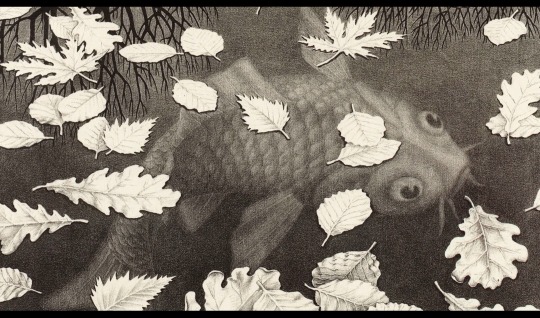
Movies I watched this Week #124 (Year 3/Week 20):
Costa Brava, Lebanon, my 5th bittersweet Lebanese film, debut feature from a young female director. A family of five escaped the chaos of near-future, dysfunctional Beirut to a rural, isolated compound in the mountains. But after 8 years of building a loving nest for themselves, a landfill is being constructed next to their plot and their ideal world implodes. The city trash they tried to leave behind is following them here.
The wife is being played by Nadine Labaki, who directed the Oscar-nominated ‘Capernaum’, which I’m going to watch next. The two young girls are terrific too.
The trailer. 7/10.
🍿
Another controversial first feature from a female director, Instinct by the Dutch Halina Reijn [who went after that to direct A24′s ‘Bodies Bodies Bodies’]. An intense psychological thriller about prison therapist Carice van Houten becoming obsessed with an inmate, a violent serial rapist on the verge of being paroled.
Exploring female rape fantasies is a recipe for sensationalism and manipulation, when played out for example by male-gazing misogynists like Paul Verhoeven. But in Reijn hands this dark and ominous tale is (for the most par) told with nuance and ambiguity. A powerful 7/10.
The trailer.
🍿
Massimo Troisi X2:
🍿 Re-watch: Englishman Michael Radford’s Italian classic Il Postino. A nostalgic and enchanting story of a simple postman and his friendship with Chilean poet Pablo Noruda on a small Mediterranean island in the 1950′s. Similar vibes as ‘Cinema Paradiso’, which came a few years earlier, and which also starred Philippe Noiret. A Massimo Troisi’s passion project, and infamous for him dying the very next day after principal photography ended. 10/10.
🍿 Massimo Troisi was actually an acclaimed director, screenwriter and actor before playing ‘The Postman’. But his directorial debut comedy I'm Starting from Three (Ricomincio da tre), with himself as a shy, bumbling caricature of a young man, was nothing but funny. 1/10.
Both movies feature my favorite character actor Renato Scarpa, the memorable inspector from ‘Don’t look now’ (“Signor Baaxter!”).
🍿
Paul McCartney: The Space Within Us, an infectious 2006 concert film, documenting his smashing “US” tour (37 US shows, 565,000 tickets sold, $77 million taken in), when he was 64...
The director of this documentary was absolutely terrible; He filled up the two hours with extremely fast zooms in and out, nervous camera movements, super-quick editing and too many sappy reaction shots of adoring fans in the audience (lots of parents and grandparents with children of all ages, though!). Also, too many celebrities ‘Talking Heads’ emoting how great McCartney is, which was off-putting. Still, the incredible performances of the band, the sensational, live-wire concerts, the enthusiastic music made it a tearful inspiration.
My best film experience of the week! 9/10.
On McCartney’s website, there's a list of 25 documentaries about him, which I will watch one by one, Inshallah.
🍿
In the fine M.C. Escher: Journey to Infinity documentary, he claimed that he was not an artist, but a mathematician. The film brings to life his geometric-abstract visions. And while it touches on the relationship between him and Bach’s, it never mentions Gödel. Not crazy about the Stephen Fry narration. 8/10. (Photo Above).
🍿
Documentary No. 3 of the week: Still, the new heartfelt Michael J. Fox bio-pix combines lots of re-enactments with footage from old movies, as well as some current heart-to-heart interviews about his Parkinson’s.
As a celebrity portrait, it wasn’t relevant to me at all, since I never saw any of his TV work, or even his movies. But the parts about his disability were powerful though.
🍿
2 Russian classics that didn’t resonate with me:
🍿 First watch: Tarkovsky’s 3-hour-long experimental poem about memory, Solaris, his attempt to show that ‘Science-fiction films don’t have to be emotionally shallow’. It must have had a strong influence to the game ‘Myst’, being cultish, mysterious and atmospheric. But its slow-moving premise became so boring to me, that it took me 3 days to finish it. Comparing it to 2001 is unjustified. 2/10.
I planned on following it up with Steven Soderbergh’s later version, but then I hard-passed: Disliking science-fiction movies in general, and hating Hollywood remakes in particular is not a good incentive.
🍿 The Cranes Are Flying, a Soviet World War 2 drama from 1957. As a political expression of the new era after Stalin’s death, it may have been be significant, but today it seems a simple propaganda piece, with some bold visuals. 2/10.
🍿
Mika Kaurismäki is Aki’s older brother and the one who got him interested in movie making. My first film by him, Helsinki Napoli All Night Long was disappointing though: An European-Noir inspired by hardcore American crime stories, and even the cameos of Eddie Constantine, Sam Fuller, Jim Jarmusch and Wim Wender didn’t save it from being a poor parody. 1/10.
🍿
You Can Live Forever, a shallow Canadian romance of two young girls, one of which is a Jehovah Witness, torn between her faith and her love. The other one looks like young Scarlett Johansson but can’t act like her. The flat queer coming-of-age against a fucked-up puritan background had no subtext. It felt auto-biographical, and it actually was. 2/10.
🍿
Who done it?, My 4th (atrocious!) film by Basil Dearden. After 2 unsung masterpieces (’Victim’ and ‘All night long’), and another thought-provoking work (‘Sapphire), this was a terrible ‘Ouch’. A late Ealing Studios low-brow, un-funny ‘comedy’ and Benny Hill's film debut as a bumbling Inspector Clouseau-like fool. Very disappointing 1/10.
🍿
“Put him in a straitjacket and give him an enema! Wait, give him an enema first, then put him in a straitjacket!”
Dracula, dead and loving it, the last film directed by Mel Brooks, an underrated (?) gothic parody. But he already did a much better Transylvanian castle spoof with ‘Young Frankenstein’, and this one just sucked. Leslie Nielsen sporting a Borat accent, and Brooks double-playing the Hungarian angle. The silliness of the occult, should be good for parodies, but not here. 1/10.
As a successful producer, Mel Brooks made ‘The elephant man’, ‘Frances’, ‘The fly’, others...
🍿
2 British shorts by Sam Baron, both with the same Amit Shah:
🍿 Big ears, a little story about a gawky young man with large Obama-ears, who gets very bad news.
🍿 “Hi, I’m here for the orgy” - His earlier short was crisper (and funnier). The orgy, a 15-min. comedy about the same lonely, awkward man who goes to his first orgy. 6/10.
🍿
I adored Jonathan Glazer’s three previous films (’Sexy Beast’, ‘Birth’, and ‘Under the skin’), so I’m eagerly waiting for what is supposedly a new disturbing masterpiece from him, ‘The zone of Interest’ (It was based on a novel by Martin Amis, who just died yesterday!).
Glazer used to have a YouTube channel with some of the many film-like commercials he had directed before branching into features. Here are a few of his standalone ads:
Stella Artois Ice Skating Priests, Last orders and Devil's Island (with Ron Perlman) *
Sony Bravia Paint *
Guinness’s Surfer and Swimblack and Dreamer *
Levi’s Kung Fu and Odyssey *
Wrangler’s Ride *
Barclay Bank’s Centaur (with Samuel L Jackson) *
Apple watch Flight *
More Here *
Unrelated: Christopher Walken Sky-dancing in Fatboy slim Weapon of choice, by Spike Jonze.
🍿
Throw-back to the "Art project”:
🍿
(My complete movie list is here).
1 note
·
View note
Text
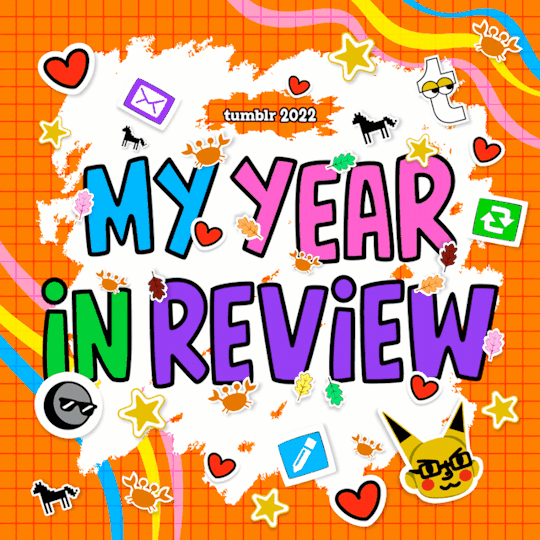
I posted 365 times in 2022
That's 358 more posts than 2021!
237 posts created (65%)
128 posts reblogged (35%)
Blogs I reblogged the most:
@borfbork
@queerlywren
@asxitxis
@incorrectosemanverse
@clean-swift
I tagged 183 of my posts in 2022
Only 50% of my posts had no tags
#osemanverse - 14 posts
#owl house - 12 posts
#hearstopper - 10 posts
#music - 10 posts
#fandom weeks - 10 posts
#paper girls - 10 posts
#loveless - 9 posts
#harry potter - 9 posts
#heartstopper - 9 posts
#yay - 9 posts
Longest Tag: 77 characters
#yes i am going to be posting lyrics from songs no one knows for the next hour
My Top Posts in 2022:
#5
petition for heartstopper to have their own netflix icons
43 notes - Posted September 12, 2022
#4
i saw your post about the osemanverse characters's birthdays and i was wondering if you have a list of them and if you wouldn't mind sharing it?
omg yes uh i dont have a list but ill make one ⬇️ (ill try to remember all of them but u can tell me any i forget)
Charlie Spring: April 27, 1995
Nick Nelson: September 4, 1993
Tori Spring: April 5, 1994 (im guessing, cus it didnt say)
Micheal Holden: just says “january-september”
Aled Last: August 15, 1995
Daniel Jun: also doesn’t say
Frances Janvier: November 1, 1995
Carys Last: August 15, 1995
Raine Sengupta: also doesnt say
Becky Allen: January 1994(all it says)
Tao Xu: September 23, 1995 (guessing the year)
Elle Argent: May 4, 1994
Tara Jones: July 3, 1994
Darcy Olsson: January 9, 1994
Jimmy Kaga-Ricci: August 24, 1998
Lister Bird: September 19, 1997
Angel Rahimi: just says 1999
Rowan Omondi: February 2, 1998
Bliss Lai: says nothing
Juliet Schwartz: just says 1998/1999
Mr Ajayi: doesn’t say
Mr Farouk: also doesn’t say
Georgia Warr: June 13, (doesn’t say year)
Rooney Bach: November 15, (doesn’t say)
Pip Quintana: July 29, (also doesn’t say)
Jason Farley-Shaw: May 12, (i’m just gonna stop saying when it doesn’t say)
Sunil Jha: January 2
also just to save time it doesn’t say like any of the parents so
See the full post
47 notes - Posted October 16, 2022
#3
Eddie: so you aren’t going to help me?
Richie: Nope
Eddie: And nothing i can do can convince you otherwise?
Richie: i didn’t say nothing
Eddie: and i’m not marrying you
Richie: then i’m not helping you
credits to: @akwardsilince for the thingy
67 notes - Posted October 13, 2022
#2
not me adding every osemanverse character’s birthday to my calendar so it looks like i have friends
69 notes - Posted October 16, 2022
My #1 post of 2022
uh so i’m trying to make some friends on here (that sounds rlly weird i swear i’m not a old person) so i wanted to do one of those like list ur top 10 things or whatever. so uh list ur top 10 osemanverse characters (doesn’t have to be in order) and then tag 10 people and they do the same thing. so yeah here mine:
- Charlie Spring
- Lister Bird
- Tori Spring
- Pip Quintana
- Rooney Bach
- Aled Last
- Jimmy Kaga-Ricc
-Micheal Holden
- Nick Nelson
- Frances Janvier
@radio-not-silent @saturnisaprettyplanet @pessimisticatlover @aledradio @aledradiolast @thearkangels @sexynugget @osemanverseprideflags @osemanverse @evahar
also anyone else who wants to do this can!
uh sorry if this is annoying i’m just trying to meet new people (again i swear i’m not 54 or like 7)
218 notes - Posted October 4, 2022
Get your Tumblr 2022 Year in Review →
#tumblr2022#year in review#my 2022 tumblr year in review#your tumblr year in review#i’m so happy right now
1 note
·
View note
Note
Multiples of 7 for the Spotify thing <3
7. The song that had me bawling when they played the opening in my Wrapped story! I've mentioned Hair Match a bunch of times, but this is actually the FIRST song on that playlist, and it's a song that Ryn asked me to play for them on laptop over the phone while they were in inpatient in the spring, and I loved the original, and so I built a whole playlist out of bookending this at the beginning and the original at the end, and I hadn't heard it since the morning Ryn died. They said it was the best playlist they'd ever gotten.
14. This was one of my first cassette tapes, when it was new and I was in junior high, and then it was on my main fic writing playlist, and then on our Reckoning playlist, which I put for the first time in a while when I went for a walk the morning after Ryn died.
21. This is the one song on That Album that actually reminds me less of this grief, and more of the strange grief of after I left my ex.
28. Oh look, more Bach!
35. Ryn put this on a playlist for me, and that's how it ended up on the master "Romancé" playlist, which was one of my regular rotations until September. It's surprisingly fun.
42. I believe also Romancé playlist, also from Ryn? Not 100% sure tho. Iron and Wine does do some good covers.
49. Bach continuing to rock
56. I found out recently that these guys started as *Christian music* (from a former evangelical friend who was deep in that scene) and I haaaaate that I can't tell Ryn because it's that kind of curséd knowledge that you have to share. Also I love that they put this on a playlist for me, even though it's a song that was big when I was younger.
63. I think I put this on a playlist for them? Possibly because Spotify kept adding it to the end of other playlists. I made one called "the algorithm loves you" out of stuff it threw in after playing a whole list.
70. There's no fucking numbers on this playlist, at least not in the android app, so I've been counting by hand, and when I posted Get Famous it was by approximating how many songs per screen. But apparently that was wrong, and Get Famous is #70, so here's number 69: even more Bach
(suite #3 was my favorite to play, actually)
(I've hit the limit, so I might continue later, or maybe not, we'll see)
2 notes
·
View notes
Text
also while i’m posting just absolute jackshit nonsense: people read 77-2? like, people have read 77-2? and think about it? i still get fucking blindsided by this because i don’t see people talk about it, like, ever, except every time i’ve entered a discord and mentioned offhand that i wrote 77-2 at least like, five people i’ve never met go DUDE YOU WHAT? WE HAVE A CELEBRITY AMONG US or something like that
and i just short-circuit instantly because like, i do not consider it popular, it’s a niche s6 au that a very scant handful of people (all of whom i am friends with) have done art for, the 77-2 discord getting a new member is a rarity these days, and i have never seen it discussed much outside of me bringing it up or discussion in the discord itself
and yet somehow? people read this? like people have just read it, gone “huh that was cool i guess” and now i’m considered as having a scant amount of clout? it’s so fucking weird to me man idk what to think
#i guess i assume that popularity can be measured by how many people talk about the thing#when apparently 77-2 is like. this silent monolithic Thing that people read but don't talk about?#which on the one hand is very On Brand for the type of cryptid i am but on the other hand. Fead Bach................. :(#txt#orig#misc#772 au#edit: also yeah i just. want to talk abt 77-2 man. i like this funky au a lot and i miss getting anons about it#it feels Weird that it’s like. out in the wild and something people know about but barely discuss#like just. !?!?!?!?!?!? yanno
11 notes
·
View notes
Text
Yearly Reading Wrap Up: 2020

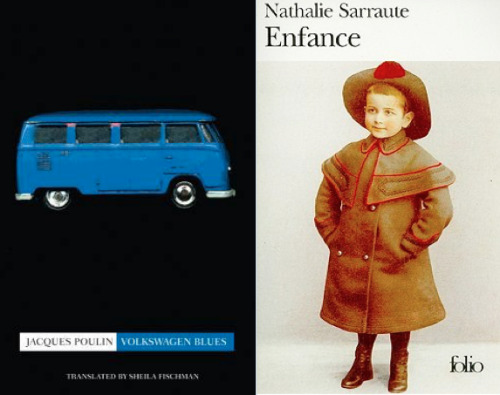
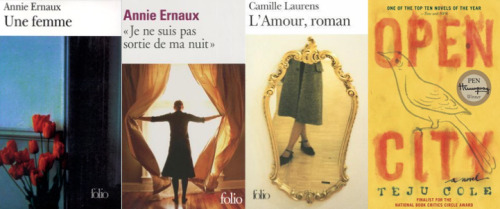
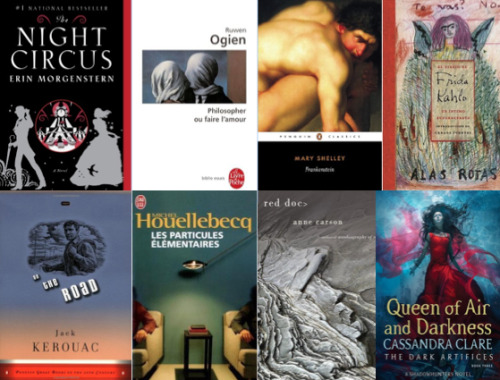
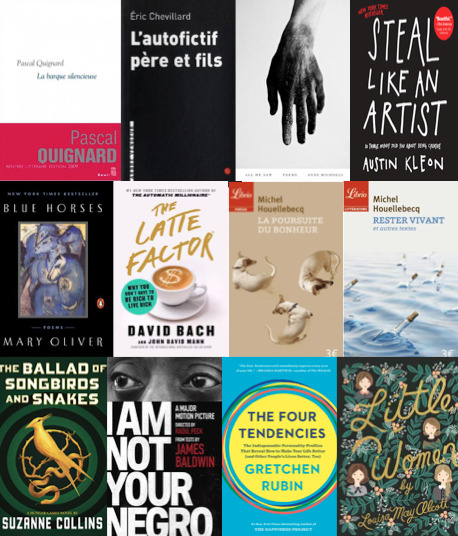
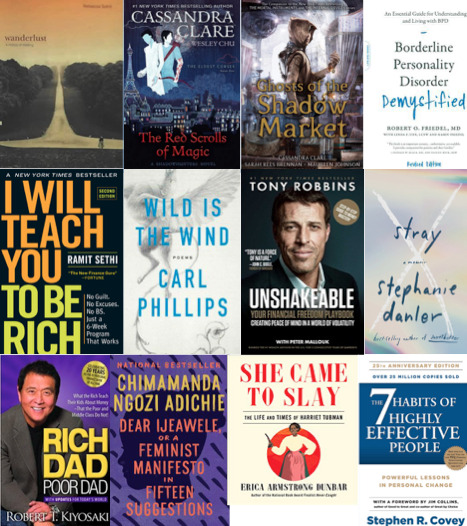
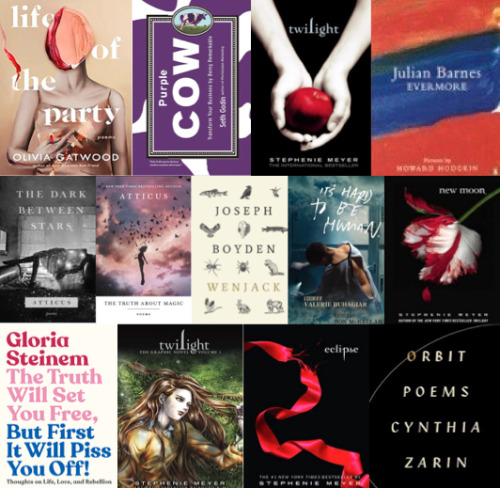


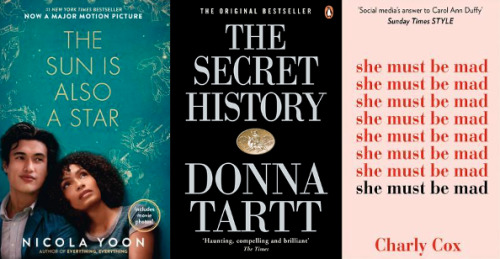


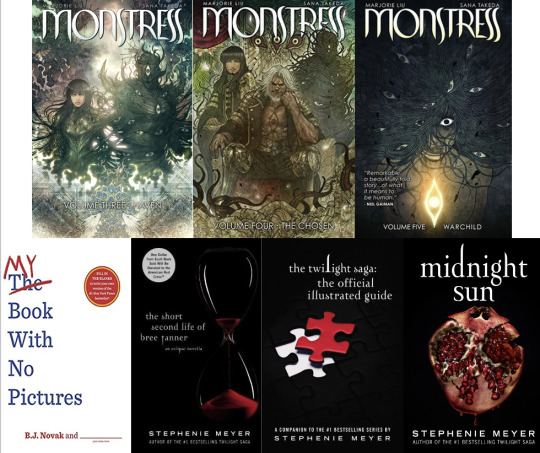
1. La Description Du Monde by Marco Polo ⭐⭐
2. Du côté de chez Swann (À la recherche du temps perdu #1) by Marcel Proust ⭐⭐⭐
3. Discours Du Récit by Gérard Genette ⭐⭐⭐
4. The Private Life of the Diary by Sally Bayley ⭐⭐⭐⭐
5. Anna Karenina by Leo Tolstoy ⭐⭐⭐⭐⭐
6. Let it Snow by John Green ⭐⭐⭐⭐
7. The Loneliness of the Long-Distance Runner by Alan Sillitoe ⭐⭐⭐⭐
8. Roland Barthes by Roland Barthes by Roland Barthes ⭐⭐⭐⭐
9. L'ignorance by Milan Kundera ⭐⭐⭐⭐
10. Mary Ventura and the Ninth Kingdom: A Story by Sylvia Plath ⭐⭐⭐⭐
11. Volkswagen Blues by Jacques Poulin ⭐⭐⭐⭐⭐
12. Enfance by Nathalie Sarraute ⭐⭐⭐⭐
13. Une femme by Annie Ernaux ⭐⭐⭐⭐
14. Je ne suis pas sortie de ma nuit by Annie Ernaux ⭐⭐⭐⭐
15. L’Amour, roman by Camille Laurens ⭐⭐⭐⭐⭐
16. Open City by Teju Cole ⭐⭐⭐⭐
17. The Night Circus by Erin Morgenstern ⭐⭐⭐⭐
18. Philosopher ou faire l'amour by Ruwen Ogien ⭐⭐⭐⭐⭐
19. Frankenstein by Mary Wollstonecraft Shelley ⭐⭐⭐⭐
20. The Diary of Frida Kahlo: An Intimate Self-Portrait by Frida Kahlo ⭐⭐⭐
21. On the Road by Jack Kerouac ⭐⭐
22. Les particules élémentaires by Michel Houellebecq ⭐⭐⭐⭐⭐
23. Red Doc> (Red #2) by Anne Carson ⭐⭐⭐⭐
24. Queen of Air and Darkness (The Dark Artifices #3) by Cassandra Clare ⭐⭐⭐⭐⭐
25. La Barque silencieuse by Pascal Quignard ⭐⭐⭐
26. L'autofictif père et fils by Éric Chevillard ⭐⭐⭐
27. All We Saw: Poems by Anne Michaels ⭐⭐⭐⭐⭐
28. Steal Like an Artist by Austin Kleon ⭐⭐⭐⭐
29. Blue Horses: Poems by Mary Oliver ⭐⭐⭐⭐
30. The Latte Factor by David Bach ⭐⭐⭐⭐
31. La Poursuite du bonheur by Michel Houellebecq ⭐⭐⭐⭐
32. Rester vivant: et autres textes by Michel Houellebecq ⭐⭐⭐
33. The Ballad of Songbirds and Snakes (The Hunger Games #0) by Suzanne Collins ⭐⭐⭐⭐⭐
34. I Am Not Your Negro by James Baldwin ⭐⭐⭐⭐⭐
35. The Four Tendencies by Gretchen Rubin ⭐⭐⭐
36. Little Women by Louisa May Alcott ⭐⭐⭐⭐⭐
37. Wanderlust: A History of Walking by Rebecca Solnit ⭐⭐⭐⭐
38. The Red Scrolls of Magic (The Eldest Curses #1) by Cassandra Clare ⭐⭐⭐⭐
39. Ghosts of the Shadow Market by Cassandra Clare ⭐⭐⭐⭐
40. Borderline Personality Disorder Demystified by Robert O. Friedel ⭐⭐⭐⭐
41. I Will Teach You to Be Rich by Ramit Sethi ⭐⭐⭐⭐
42. Wild Is the Wind by Carl Phillips ⭐⭐⭐⭐
43. Unshakeable by Anthony Robbins ⭐⭐⭐⭐
44. Stray by Stephanie Danler ⭐⭐⭐⭐⭐
45. Rich Dad, Poor Dad by Robert T. Kiyosaki ⭐⭐⭐⭐
46. Dear Ijeawele, or A Feminist Manifesto in Fifteen Suggestions by Chimamanda Ngozi Adichie ⭐⭐⭐⭐⭐
47. She Came to Slay by Erica Armstrong Dunbar ⭐⭐⭐⭐⭐
48. The 7 Habits of Highly Effective People by Stephen R. Covey ⭐⭐⭐⭐
49. Life of the Party by Olivia Gatwood ⭐⭐⭐⭐
50. Purple Cow: Transform Your Business by Being Remarkable by Seth Godin ⭐⭐⭐⭐
51. Twilight (The Twilight Sage #1) by Stephanie Meyer ⭐⭐⭐⭐⭐
52. Evermore by Julian Barnes ⭐⭐⭐
53. The Dark Between Stars by Atticus Poetry ⭐
54. The Truth About Magic by Atticus Poetry ⭐
55. Wenjack by Joseph Boyden ⭐⭐
56. It’s Hard to Be Human by Valerie Buhagiar ⭐⭐⭐⭐
57. New Moon (The Twilight Saga #2) by Stephenie Meyer ⭐⭐⭐⭐⭐
58. The Truth Will Set You Free, But First It Will Piss You Off! by Gloria Steinem ⭐⭐⭐⭐
59. Twilight: The Graphic Novel, Vol. 1 by Young Kim ⭐⭐⭐⭐
60. Eclipse (The Twilight Saga #3) by Stephenie Meyer ⭐⭐⭐⭐
61. Orbit: Poems by Cynthia Zarin ⭐⭐⭐
62. The Power of Now by Eckhart Tolle ⭐⭐⭐⭐
63. The Poet X by Elizabeth Acevedo ⭐⭐⭐⭐⭐
64. A Very Large Expanse of Sea by Tahereh Mafi ⭐⭐⭐⭐
65. Breaking Dawn (The Twilight Saga #4) by Stephenie Meyer ⭐⭐⭐⭐⭐
66. Your Money or Your Life by Vicki Robin ⭐⭐
67. In Conclusion, Don’t Worry About It by Lauren Graham ⭐
68. My Ideal Bookshelf by Thessaly La Force ⭐⭐⭐⭐⭐
69. Things We Lost in the Fire by Mariana Enríquez ⭐⭐⭐⭐⭐
70. Saga Vol. 9 by Brian K. Vaughan ⭐⭐⭐⭐⭐
71. I’m Thinking of Ending Things by Iain Reid ⭐⭐⭐⭐⭐
72. #GIRLBOSS by Sophia Amoruso ⭐⭐⭐⭐
73. Outliers: The Story of Success by Malcolm Gladwell ⭐⭐⭐⭐
74. Violet Bent Backwards Over the Grass by Lana Del Rey ⭐⭐⭐⭐⭐
75. The Sun Is Also a Star by Nicola Yoon ⭐⭐⭐
76. The Secret History by Donna Tartt ⭐⭐⭐⭐⭐
77. She Must Be Mad by Charly Cox ⭐⭐⭐
78. home body by Rupi Kaur ⭐⭐⭐⭐⭐
79. Wind in a Box by Terrance Hayes ⭐⭐⭐
80. No One Is Too Small to Make a Difference by Greta Thunberg ⭐⭐⭐⭐
81. Howl and Other Poems by Allen Ginsberg ⭐⭐⭐⭐⭐
82. Normal People by Sally Rooney ⭐⭐⭐⭐⭐⭐
83. Almost Midnight: Two Festive Short Stories by Rainbow Rowell ⭐⭐⭐
84. A Christmas Carol by Charles Dickens ⭐⭐⭐
85. Holidays on Ice by David Sedaris ⭐⭐
86. Monstress, Vol. 3: Haven (Monstress #3) by Marjorie M. Liu ⭐⭐⭐⭐
87. Monstress, Vol. 4: The Chosen (Monstress #4) by Marjorie M. Liu ⭐⭐⭐
88. Monstress, Vol. 5: Warchild (Monstress #5) by Marjorie M. Liu ⭐⭐⭐
89. My Book With No Pictures by B.J. Novak ⭐⭐⭐⭐⭐
90. The Short Second Life of Bree Tanner (The Twilight Saga #3.5) by Stephenie Meyer ⭐⭐⭐⭐
91. The Twilight Saga: The Official Illustrated Guide by Stephenie Meyer ⭐⭐⭐⭐
92. Midnight Sun (The Twilight Saga #5) by Stephenie Meyer ⭐⭐⭐⭐
#yearly reading wrap up#2020#2020 books#goodreads#star raitings#books#fiction#literature#French books#French literature#English literature#classics#the twilight saga#graphic novels#reading list#reading wrap up
12 notes
·
View notes
Text
WASHINGTON, DC (Catholic Online) - “I started this list as the 100 Best Pieces of Sacred Music, but I decided instead to recommend specific recordings. Why? No matter how fine the music, say Bach's Mass in B minor, a poor performance will leave the listener wondering where the "greatness" went. So the recommendations below represent a merging of both: All of the compositions are among the very best sacred music ever written, but the recorded performances succeed in communicating their extraordinary beauty.
“I also dithered over whether or not to make a list of "liturgical" music, or "mass settings," or "requiems." Each of these would make interesting lists, but I chose the broader "sacred music" with the hope that this list might be of interest to a wider spectrum of people. Composers are not limited to any denomination -- some are known to have been non-believers -- although the music belongs to the Christian tradition.
“I've also decided to limit my choices to recordings that are presently available on CDs, DVDs, Blu-rays, or digital downloads. I don't expect those who are curious about a particular title to start hunting down LPs, especially since these vinyl recordings are suddenly in great demand and prices are rising.
“This list is alphabetized, rather than listed in chronological order. This was necessary, since recordings will often include several pieces composed years apart, perhaps much more. Thus, to reiterate, there has been no attempt to arrange them in order of preference -- all 100 are among "the best" recordings of sacred music currently available. The recording label is indicated in parentheses.
What I would call 'Indispensable Sacred Music Recordings' are marked with an ***.
1.Allegri, Miserere, cond., Peter Phillips (Gimell).***
2.Bach Mass in B Minor, cond., Nikolaus Harnoncourt (1968 recording;Teldec).***
3.Bach, St. Matthew Passion, cond., Philippe Herreweghe (Harmonia Mundi).***
4.Bach, Cantatas, cond., Geraint Jones and Wolfgang Gonnenwein (EMI Classics).
5.Barber, Agnus Dei, The Esoterics (Naxos).
6.Beethoven, Missa Solemnis, cond., Otto Klemperer (EMI/Angel).
7.Bernstein, Mass, cond., Leonard Bernstein (Columbia).
8.Berlioz, Requiem, cond. Colin Davis (Phillips).
9.Brahms, Requiem, cond., Otto Klemperer (EMI/Angel).***
10.Briggs, Mass for Notre Dame, cond., Stephen Layton (Hyperion).
11.Britten, War Requiem, cond., Benjamin Britten (Decca).
12.Brubeck, To Hope! A Celebration, cond. Russell Gloyd (Telarc).
13.Bruckner, Motets, Choir of St. Mary's Cathedral (Delphian).***
14.Byrd, Three Masses, cond., Peter Phillips (Gimell).
15.Burgon, Nunc Dimittis, cond., Richard Hickox (EMI Classics).
16.Celtic Christmas from Brittany, Ensemble Choral Du Bout Du Monde (Green Linnet)
17.Chant, Benedictine Monks of Santo Domingo de Silos (Milan/Jade).
18.Charpentier, Te Deum in D, cond., Philip Ledger (EMI Classics).
19.Christmas, The Holly and the Ivy, cond., John Rutter (Decca).
20.Christmas, Christmas with Robert Shaw, cond., Robert Shaw (Vox).
21.Christmas, Cantate Domino, cond., Torsten Nilsson (Proprius).***
22.Christmas, Follow That Star, The Gents (Channel Classics).
23.Christmas, The Glorious Sound of Christmas, cond., Eugene Ormandy (Sony).
24.Christmas: Moravian Christmas, Czech Philharmonic Choir (ArcoDiva)
25.Desprez, Ave Maris Stella Mass, cond., Andrew Parrott (EMI Reflexe).
26.Dufay, Missa L'homme arme, cond., Paul Hillier (EMI Reflexe).
27.Duruflle, Requiem & Motets, cond. Matthew Best (Hyperion)
28.Dvorak, Requiem, cond. Istvan Kertesz (Decca).
29.Elgar, The Dream of Gerontius, cond. John Barbirolli (EMI Classics).***
30.Elgar, The Apostles, cond. Adrian Boult (EMI Classics).
31.Elgar, The Kingdom, cond., Mark Elder (Halle).
32.Eton Choirbook, The Flower of All Virginity, cond., Harry Christophers (Coro).
33.Faure, Requiem, cond., Robert Shaw (Telarc).
34.Finnish Sacred Songs, Soile Isokoski (Ondine).
35.Finzi, In Terra Pax, cond. Vernon Handley (Lyrita).
36.Gabrieli, The Glory of Gabrieli, E. Power Biggs, organ (Sony).
37.Gesualdo, Sacred Music for Easter, cond., Bo Holten (BBC).
38.Gonoud, St. Cecilia Mass, cond. George Pretre (EMI Classics).
39.Gorecki, Beatus Vir & Totus Tuus, cond. John Nelson (Polygram).
40.Gospel Quartet, Hovie Lister and the Statesman (Chordant)
41.Guerrero, Missa Sancta et immaculata, cond., James O'Donnell (Hyperion)
42.Handel, Messiah, cond., by Nicholas McGegan (Harmonia Mundi)***
43.Haydn, Creation, cond., Neville Marriner (Phillips).
44.Haydn, Mass in Time of War, cond., Neville Marriner (EMI Classics).
45.Hildegard of Bingen, Feather on the Breath of God, Gothic Voices (Hyperion).
46.Howells, Hymnus Paradisi, cond., David Willocks (EMI Classics).***
47.Hymns, Amazing Grace: American Hymns and Spirituals, cond. Robert Shaw (Telarc).***
48.Lauridsen, Lux Aeterna & O Magnum Mysterium, cond. Stephen Layton (Hyperion).***
49.Lassus, Penitential Psalms, cond. Josef Veselka (Supraphon).
50.Leighton, Sacred Choral Music, cond., Christopher Robinson (Naxos).
51.Liszt, Christus, cond., Helmut Rilling (Hannsler).
52.Liszt, The Legend of St. Elisabeth, cond., Arpad Joo (Hungaroton).
53.Lobo, Requiem for Six Voices, cond., Peter Phillips (Gimell).
54.Martin, Requiem, cond. James O'Donnell (Hyperion).
55.Machaut, La Messe de Nostre Dame, cond., Jeremy Summerly (Naxos).
56.Mahler, 8th Symphony, cond., George Solti (Decca).
57.Mendelssohn, Elijah, cond. Rafael Frühbeck de Burgos (EMI
58.Monteverdi, 1610 Vespers, cond., Paul McCreesh (Archiv).
59.Morales, Magnificat, cond., Stephen Rice (Hyperion).
60.Mozart, Requiem, cond. Christopher Hogwood (L'Oiseau-Lyre).
61.Mozart, Mass in C Minor, cond. John Eliot Gardiner (Phillips).
62.Nystedt, Sacred Choral Music, cond., Kari Hankin (ASV).
63.Organum, Music of the Gothic Era, cond., David Munrow (Polygram).
64.Palestrina, Canticum Canticorum, Les Voix Baroques (ATMA).
65.Palestrina, Missa Papae Marcelli, cond. Peter Phillips (Gimell).
66.Part, Passio (St. John Passion), cond., Paul Hillier (ECM New Series).
67.Parsons, Ave Maria and other Sacred Music, cond., Andrew Carwood (Hyperion).
68.Pizzetti, Requiem, cond., James O'Donnell (Hyperion).
69.Poulenc, Gloria & Stabat Mater, cond., George Pretre (EMI Classics).
70.Poulenc. Mass in G Major; Motets, cond., Robert Shaw (Telarc).
71.Puccini, Messa di Gloria, cond., Antonio Pappano (EMI Classics).
72.Purcell, Complete Anthems and Services, fond., Robert King (Hyperion).
73.Rachmaninov, Liturgy of St. John Chrysostom, cond., Charles Bruffy (Nimbus).
74.Rachmaninov, Vespers, cond., Robert Shaw (Telarc).
75.Respighi, Lauda Per La Nativita Del Signore, cond., Anders Eby Proprius).
76.Rheinberger, Sacred Choral Music, cond., Charles Bruffy (Chandos).
77.Rossini, Stabat Mater, cond., Antonio Pappano (EMI).
78.Rubbra, The Sacred Muse, Gloriae Dei Cantores (Gloriae Dei Cantores).
79.Rutter, Be Thou My Vision: Sacred Music, cond., John Rutter (Collegium).***
80.Russian Divine Liturgy, Novospassky Monastery Choir (Naxos).
81.Rutti, Requiem, cond., David Hill (Naxos).
82.Saint Saens, Oratorio de Noel, cond., Anders Eby (Proprius).
83.Schubert, 3 Masses, cond., Wolfgang Sawallisch (EMI Classics).
84.Schutz, Musicalische Exequien, cond., Lionel Meunier (Ricercar).
85.Spirituals, Marian Anderson (RCA).***
86.Spirituals, Jesse Norman (Phillips)
87.Telemann, Der Tag des Gerichts, cond., Nikolaus Harnoncourt (Teldec).
88.Thompson, Mass of the Holy Spirit, cond., James Burton (Hyperion).
89.Shapenote Carols, Tudor Choir (Loft Recordings)
90.Stravinsky, Symphony of Psalms, cond., Robert Shaw (Telarc).
91.Tallis, Spem in alium & Lamentations of Jeremiah, cond., David Hill (Hyperion).***
92.Tschiakovsky, Liturgy of St. John Chrysostom, cond, Valery Polansky (Moscow Studio).
93.Taneyev, At the Reading of a Psalm, cond., Mikhail Pletnev (Pentatone).
94.Vaughn Williams, Five Mystical Songs, cond., David Willcocks (EMI Classics).***
95.Vaughn Williams, Mass in G, cond. David Willcocks (EMI Classics).
96.Vaughn Williams, Pilgrims Progress, cond., Adrian Boult (EMI Classics).***
97.Verdi, Requiem, cond., Carlo Maria Guilini (EMI Classics).***
98.Victoria, O Magnum Mysterium & Mass, cond., David Hill (Hyperion).***
99.Victoria, Tenebrae Responsories, cond., David Hill (Hyperion).
100.Vivaldi, Sacred Music, cond., Robert King (Hyperion). “
-----
Deal W. Hudson is president of the Pennsylvania Catholics Network and former publisher/editor of Crisis Magazine. Dr. Hudson also a partner in the film/TV production company, Good Country Pictures.
13 notes
·
View notes
Photo

My little planet, Galust Mkhitaryan
I created a "world list". Even many famous and good people did not get into this work, but they are much more on the list, I'll draw the next time. In the picture all the colors, all the styles in the painting. 252 people, 252 masterpieces, portraits. in this picture are depicted 252 influential people of our planet. People who created our world. The painting is a real museum exhibit, where he painted 252 masterpieces. The very first king from the Mesopotamia, known science Alilum a2 - Lu-Lim XXX BC famous Gilgamesh XXVII-XXVI and the first pharaoh of the first dynasty of Egypt Menes. in my list found the places Iisus Hristos, Muhammad, In the list I painted portraits of great scientists and artists. Great artists and athletes. My heroes, from all over the world and states. There are heroes from China, America, from Central America, from Europe, from Russia. from Armenia and from the East. Successful businessmen of all time, the famous Morgan, Rockefeller and today's Mark Zucemberg. In the picture I drew and negative people in the negative form is Hitler, this is Stalin is Lenin and others. Features of the picture. Thanks to my work, many ancient heroes found their faces. Based on ancient sketches, sculptures and bas-reliefs, I created their faces. Now, Kleopatra,. Tutankhamen, Gilgamesh, Hammurabi have their scientific faces. I was inspired to this work by a portrait of SirWinston Churchill and Charlie Chaplin. After I thought of drawing all the influential people. In the picture, I decided to use different styles, and genres for a change. I also want to show the world to the whole world that the 1915 scum of the Turks cut out such a talented people as the Armenians, and I drew representatives of the Armenian people such as Aram Khacaturyan Charles Aznavour Michel Legrand and many Armenian origins. This is my list of the World, I believe that it is necessary to create such a picture list and make people happy, so that everyone can see on one canvas at once. In the future I will draw even more people, many modern people who did not get into the picture let me be forgiven, because this was the first work. and was very difficult. I think that the picture will be very interesting and attractive. People will walk with phones, turn on the Internet and look for those who are pictured in the picture. At the opening of the exhibition, there will be a queue for viewing portraits. This picture I spent 7 months enjoying the viewers, I dream that people learn from newspapers and from the Internet go and look at this work, in any city where I go to show, there will be numerous views. I specifically tried to draw different styles and techniques. I documented the video snapshots sent by representatives of Guinness World Records. I hope that a positive response will come and I will set a record., The real value of the picture is 1 million Euro. I in other sites exhibited a picture for a million dollars. In Saatchi there is a limit of 100 thousand dollars, so I put out 100 thousand. If in the Saatchi Site the first person who buys something I will sell for 100 thousand dollars. .List of people 1.Gautama Budda Born c. 563 BCE or c. 480 BCE Died c. 483 BCE or c. 400 BCE 2.Maria Mother of Jesus Third quarter of de icentury BC. The middle of the 1st century 3.Iisus Hristos 4 î.Hr. 33 d.Hr. 4. Muhammad April 26, 570 January 8, 632 5 Hayk XXXII or XXX centuries BC. E. 6.Piotr Weliki 30may 1672 28 January 1725 7.Elizabeth I. 7 September 1533 24march 1603 8.Alexandr Graham Bel 3 march 2 August 1922 9.Charlies Robert Darvin 12 February 1809 19 April 1882 10.Enrico Fermi 29 September 1901 - 28 November 1954 11.Tomas Woodrow Wilson 28 Dekember 1856 3 February 1924 12.Winston Churchill Sir 30 November 1874 24 January 1965 13.John F. Kennedy 29 May 1917 - 22 November 1963 14.Charles de Goulle 22 November 1890 9 November 1970 15.William Henri Gates 28 Oktober 1955 16.Minas Avetisyan 20 July 1928 24 February 1975 17.Galust Gulbenkian 23 March 1869 20 Juli 1956 18.Arshille Gorki 15 April 21 July 1948 19.Grigor Shldyan 20 August 1900 1 April 1985 20.Jean Jansem 9 March 1920 27 August 2013 21.Vuslim Magomayev 17 August 1942 25 oktober 2008 22.Demis Roussos 15 1946 25 January 2015 23. Goyko Mitich 13 Junen1940 24.Stiven Frederic Segal 10 April 1952 25. Jean-Claude Van Damme 18 October 1960 26. Alilum a2 - Lu-Lim XXX BC 27. Gilgamesh XXVII-XXVI 28.Menes 2800 BC 2700 BC 29. Kleopatra 2 November 69 12 August 30 BC 30. Nefertiti 1370 BC 1330 BC 31. Tutankhamen XVIII Dynasty of the Nev Kingdom 1332-1323 32. George Washington 22 Febrary 1732 14 December 1799 33. Hammurapi 1820 1750 BC 34. Johann Sebastian Bach 21-31 March 28 July 1750 35. Merritt Singer 27 October 1811 23 July 1875 36. Alfred Bernhard Nobel 21 October 1833 10 December 1896 37. Amerigo Vespucci 9 March 1454 22 February 1512 38. Coco Chanel 19 Augusta 1883 10 January 1971 39. Gianni Versace 2 Dekember 1948 15 July 1997 40. Stive Jobs 24 February 1955 5 October 2011 41. John Davison Rocefeller 8 July 1839 23 May 1937 42. Sr John Pierpont Morgan 17 April 31 March 1913 43. Raymond Alfred «Ray» Kroc 5 October 1902 14 January 1984 44. Andrew Carnegie 25 November 11 August 1919 45. Walter Elias Disney 5 December 1901 15 December 1966 46. Martiros Saryan 28 February 1880 5 May 1972 47. Ciorgio Armani 11 July 1930 48. Jack" Kevorkian 26 May 1928 3 June 1911 49.Garegin Nzhdeh 1 January 1886 21 December 1955 50. Arthur Abraham 20 February 1980 51. Sergei Parajanov 9 January 1924 20 July 1990 52. Tigran Petrosyan 17 June 1929 13 August 1984 53. Alessandro Safina October 14, 1963 54. Antonio Banderas 10 August 1960 55. Mark Elliot Zucemberg 14 May 1984 56. Sir Isaac Newton 25 December 1640 20 March 1726 57. Will Smith 29 September 1968 58. Leonardo Di Caprio 11 November 1974 59. Alla Pugachova 15 April 1949 60. Gyros 590 BC 530 BC 61. Flavius Valerius Aurelius Constantinus 27 Febrary 272 23 May 337 62. Asoka 304 BCE 232 BCE 63. Gaius Julius Cesar 13 July 100 BC 15 March 44 BC 64. Aleksandr Makedonski 356 July 323 BC 65. Genghis Khan 1156 - 1162 25 August 1227 66. Ferdinand Porsche 3 September 1875 January 1950 67. Emest Hemingway 21 Jule 1899 2 Jule 1961 68. Nikolaus Copernicus 19 Feruary 1473 14 May 1543 69. Michelangelo 6 March 1475 18 February 1564 70. Galileo Galilei 15 Feruary 1564 8 January 1642 71. Boris Piotrovski 14 February 1908 15 Oktober 1990 72. Henry Ford 30 July 1863 7 April 1947 73. Baron Amchel Mayer von Rotscchild 23 Febrary 1744 19 September 1812 74. Cornelius Vanderbilt 27 May 1794 4 January 1877 75. Alexander Vasilyevich Suvorov 24 November 1730 18 May 1800 .76. Vasco da Gamma 29 September 1469 24 December 1524 77. Mikhail Gorbachov 2 March 1931 78. Abraham Alikhanian 20 February 1904 8 December 1970 79. Shavarsh Karapetyan 19 May 1953 80. Andre Aggasi 29 April 1970 81. Komitas 26 September 1869 22 Oktober 1935 82. Yurik Vardanyan 13 June 1956 83. Cher Cherlyn Sarkisyan 20 May 1946 84. George Clooney 6 May 1961 85. Jackie Chan 7 April 1954 86. Jean-Paul Belmondo 9April 1933 87. Alain Delon 8 november 1935 88. Elton Jhon March 1947 89. Elvis Presley 8 January 1935 90. Cai Lun 48-62 CE 121 91. Aristotel 384 BC - 322 BC 92. Emperor Wen ot Han 202 BC 157 BC 93. Sui Wendi 21 July 541 AD 13 August 604 94. Erik Raudi Thorvaldsson 950 103 95. Leonardo Da Sir Piero da 15 April 1452 2 May 1519 96. Willam Shakespeare 1564 23 April 1616 97. Ludwig Van Beethoven December 1770 26 March 1827 98. Alexander Dumas 24 July 1802 5 December 1876 99. Mikhail Lomonosov 19 November 1711 15 April 1765 100. Fridtjof Nansen 10 October 1862 30 May 1930 101. Nelson Rolihlahla Mandela 18 July 1918 5 December 2013 102. Mother Tereza 26 August 1910 5 September 1997 103. Indira Gandhi 19 November 1917 31 October 1984 104. Karl Marx 5 May 1918 14 March 1883 105.Viktor Amazaspovich Ambartsumyan 18 September 1908 12 August 1996 106. Ovanes Aivazovski 17 Juny 1817 2 May 1900 107. Arno Babajanyan 22 January 1921 11 November 1983 108. Aram Khacaturyan 6 June 1903 1 May 1978 109. Andranik Zoravar Ozanyan 25 Feebruary 1865 31 August 1927 110. Kirk Douglas 9 December 1916 111. John Winston Lennon 9 October 1940 8 December 1980 112. Louis Daniel Armstrong 4 August 1901 6 July 1971 113. Charlie Chaplin 16 April 1889 25 Dekember 1977 114. Louis de Funes 31 July 1914 27 January 1983 115. Bruce Lee 27 November 1940 20 July 1973 116. Lise Koch 22 September 1906 1 September 1967 117. Lavrenti Pavlovich Beria 29 March 1899 23 Dekember 1953 118. Heinrich Luitpold Himmler 7 October 1900 23 May 1945 119. Lenin 22 April 1870 21 January 1924 120. Adolf Hitler 20 April 1889 30 April 1945 121. Tamerlane 9 April 1336 19 February 1405 122. Spartacus Diet in April 71 BC 123. Hipokrat 1 March 460 CE 370 CE 124. Niccolo Paganini 27 October 1782 27 May 1840 125. Robertino Lorreti 22 October 1946 126. Wolfgang Amadeus Mazart 27 January 1756 5 December 1791 127. Cristopher Columbu 31 October 1451 20 May 1506 128. Albert Einstein 14 March 1879 18 April 1955 129. Andrei Dmitrievich Shakarov 21 May 1921 14 December 1989 130. Ferdinand Magellan 3Februari 1480 27 April 1521 131. James Gamble 3 April 1803 29 April 1891 132. Isbella I de Castille 22 April 1451 26 November 1504 133. Che Guevara 14 June 1928 9 October 1967 134. Micho SUzuki 10 February 1877 27 october 1982 136. Dalai Lama 6 July 1935 137. Mesrop Mashtoch 361 17 February 441 138. Ovanes Bagramyan 2 Dekember 1897 21 September 1982 139. Gevorg Vardanyan 17 February 1924 10 January 2012 140. Hovhannes Toumanyan 19 February 1869 23 March 1923 141Movses Khorenatsi 410 CA 490 142. Raj Kapoor 14 Dekember 1924 2 June 1988 143. Fatima Rashid Nargis Dutt 1 June 1929 3 May 1981 144. Paul Mc Cartney 18 June 1942 145. Alexander Sergeyevich Pushkin 6 June 1799 10 February 1837 146. Garsia Lorca 5 June 1898 19 August 1936 147. Tigranes II 95 CE 55 CE 148. Josep Stalin 18 December 1878 5 March 1953 149. Pol Pot 19 May 1925 15 April 1996 150. Enver Pasha 22 November 1881 4 August 1922 151. Mehmed Talat pasha 10 April 1874 15 March 1921 152. Delphine La Laurie 19 March 1787 7 December 1849 153. Herostratus Diedc 356 BC 154. Amin Idi Dada 1923 16 August 2003 155. Shiro Ishii 25 June 1892 9 October 1959 156. Stiven Allan Spielberg 18 Dekember 1946 157. Julio Iglesias 23 September 1943 158. Monserrat Caballe 12 April 1933 159. John Christopher Depp 9 June 1963 160. Mark Tvain 30 November 1835 21 april 1910 161. Confucus 09 -28 551BC 479 162. Napoleon Bonapart 15 August 1769 5 May 182 163. Mansur Hasan Firdousi Tusi 935 1020 164. Nizami 1141 1209 165. Omar Khayyam 18 May 1040 4 december 1131 166. Quanah Parker 1845- 1852 25 Feburary 1911 167. Robert Bosh 23 September 1861 12 March 1942 168. Jams Clerk Maxvell 13 June 1831 5 Novwmber 1879 169. Martin Luther King 15 January 1929 4 April 1968 170. Lev Nikolaevich Tolstoy 9 September 1828 20 November 1910 171. Armen Dzhigarkhanyan 3 October 1935 172. Charles Aznavour 22 May 1924 173. Jivan Gasparyan 12 October 1928 174. Yousuf Karsh 23 December 1908 13 June 2002 175. Kim Kardashian 21 October 1980 176. Serj Tankian 21 August 1967 177. Luciano Pavarotti 12 October 1935 6 September 2007 178. Viktoria Ronjina 7 December 2011 179. Arnold Schawarzenegger 30 July 1947 180. Mel Gipson 3 January 1956 181. Sylvester Stollone 6 July 1946 182. Amitabh Bachchan 11 October 1942 183. Adriano Celentano 6 January 1938 184. Bridgitte Dordot 28 September 1934 185. Sophia Loren 20 September 1934 186. Sara Brightman 14 August 1960 187. Elizabeth Taylor 27 February 1932 23 March 2011 188. Jean Alfred Villain-Mararis 11 December 1913 8 November 1998 189. Janne d. Arc 6January 1412 30 May 1431 190. Arhimed 287 BC 191. Paul The Apostle 5-10 67 192. Jacques-Yves Cousteau 11 June 1910 25 June 1997 193. Yuri Gagarin 9March 1934 27 March 1968 194. Julius Robert Oppenheimer 22 April 1904 18 February 1967 195. Mikhail Kalashnikov 10 November 1919 23 December 2013 196. Dmitri Ivanovich Mendeleev 8 February 1834 2 February 1907 197. Simon Bolivar 24 July 1783 23 December 1830 198. Salvador Dali 11 May 1904 23 January 1989 199. Wassily Kandinsky 16 Dekember 1866 13 Dekember 1944 200. Andy Warhol 1 August 1928 22 February 1987 201. Michel Jean Legrand 24 February 1932 202. William Saroyan 31 Augusta 1908 18 May 1981 203. Artem Ivanovich Mikoyan 5 August 1905 9 December 1970 204. Larry Gagosyan 19 April 1945 205. Jean Carzou 1 January 1907 17 November 2000 206. Vasily Alekseyev 7 January 1942 25 November 2011 207. Angelina Jolie 4 June 1975 208. Aishwarya Rai 1 November 1973 209. William Bradley Pitt 18 December 1963 210. Jennifer Lynn Lopez 24. July 1969 211. Dahram Singh Deol Dharment dra 8 December 1935 212. Hema Malinini R Chakravarth c 16 Oktober 1948 213. Jordi Cruyff 25 April 1947 24 March 2016 214. Eusebio da Silva Ferrera 25 January 1942 215. Herd Muller 3 November 1945 216. Pele 21 October 1940 217.Sergei Pavlovich Korolev 12 January 1906 14 January 1966 218. Muhammad Ali 17 January 1942 3 June 2016 219. Ronaldinho Gaucho 21 March 1980 220. Adrey Shevchenko 29 September 1976 221. Pablo Picasso 25 October 1881 8April 1973 222. Paul Gauguin 7 June 1848 8 May 1903 223. Vincent Van Gogh 30 March 1853 29 July 1890 224. Zurab Tsereteli 4 January 1934 225. Ayrton Senna 21 March 1960 1 May 1994 226. John Tavares 20 September 1990 227. Lev Ivanovich Yashin 22 October 1929 20 March 1990 228. Wladimir Klitschko 25 March 1976 229. Vitali Klitschko 19 July 1971 230. Carlos Ray Chak Norris 10 March 1940 231. Alfredo James Pacino 25 April 1940 232. Michael Joseph Jackson 29 August 1958 25 June 2009 233. Marilyan Monroe 1June 1926 5 August 1962 234. Diego Armando Maradona 30 October 1960 235.Ronaldo Luis Nazario de Lama 18 September 1976 236. Lionel Andres Messi 24 June 1987 237. Cristiano Ronaldo 5 February 1985 238. Oleh Blokhin 5 November 1952 239. Michel Francois Platini 21 June 1955 240. Alex Ferguson 31 December 1941 241. Steffi Graf 14 June 1969 242. Franz Anton Beckenbauer 11 September 1945 243. Carl Lewis 1 June 1961 244. Irina Rodnina 12 September 1949 245. Michael Jeffrey Jordan 17 February 1963 246. Ezekiel Kemboi Cheboi 25 May 1982 247. Serhii Nazarovych Bubka 4 December 1963 248. Shaguille Rashaun O' Nea 6 March 1972 249. Valeri Kharlamov 14 January 1948 27 August 1981 250. Michael Schumacher 3 January 1969 251. Mike Tyson 30 June 1966 252. Mkhitaryan Galust 1 January 1959
https://www.saatchiart.com/art/Painting-My-little-planet/906390/4318854/view
3 notes
·
View notes
Text
RWBY Musings #77: The Puppet Who Wanted to be a Real Girl. Is Penny Polendina really back?
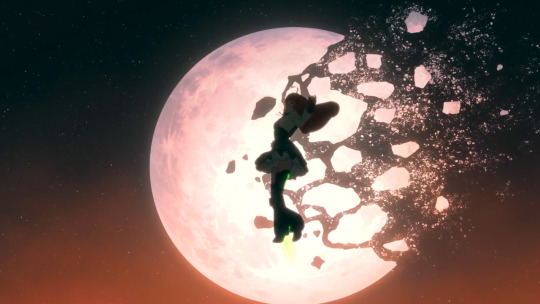
jade-rosepine asked “ While I didn't mind penny and all, I can't help asking; what was the point of bringing her back? I mean yeah wasn't beyond the realm of possibility. Only thing I could think of was to make ruby be forced to make a difficult choice - kill a friend to keep her from being used by the villians (she is still a robot and could, theoretically, be hacked by a way more advanced virus. Basically the cyber-version of brainwashing or possession!) OR let her live and be a slave to the baddies?”
Squiggles Answers:
@jade-rosepine Whelp I was going to save this bit for my musing on the first episode of RWBY V7, but since you brought it up, I might as well voice my thoughts here. I’m going to be honest with you, fam. This squiggle meister has mixed feelings about Penny’s return.
------------------------------------------------------------------------------------------------------------------------------------------------------------------------------------------
Heart of Machine
In the past, I was a big fan of the idea of Penny being rebuilt and returning for the Atlas Arc. However back then, I liked it under the pretence that she wouldn’t exactly be the same Penny Polendina that we all met back in V1. I figured she’d be an entirely different character and the justification for her being this way was so that the plot could’ve allowed for Ruby Rose to finally have some semblance of closure since it’s been shown throughout previous seasons how much Penny’s death has affected her emotionally.

As a matter of fact, as evidenced by her ‘Indomitable’ moment in V6, Penny’s death (along with Pyrhha’s and the events of the Fall of Beacon) are still a visible mental block to Ruby being able to fully utilize her Silver Eyes. Since Ruby was shown to still have much growing with mastering her unique power, I was hoping that part of her arc for this season would be coming to terms over her loss over Penny as I was certain being within her old friend’s home kingdom was bound to bring back memories of their time together.
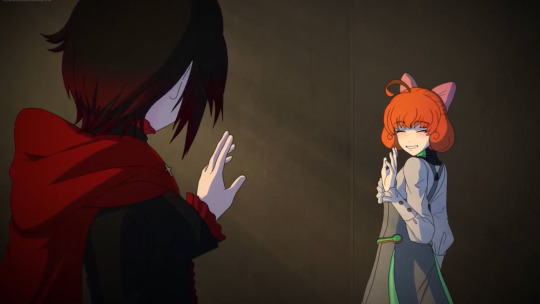
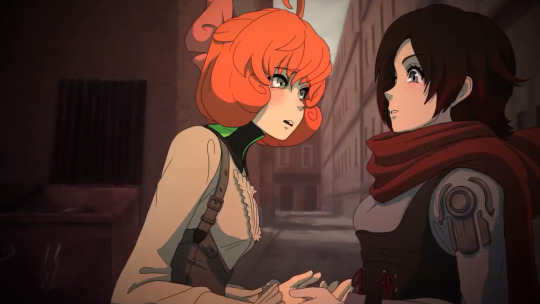
Now I’m not so sure whether or not closure with Penny will still be in the cards for Ruby. It’s not he fact that Penny returned that troubles me. It’s the fact that she returned and is presumably supposed to still be her old self but fixed now. I’m sorry but I’m just not actively buying that at all. I mean, like you, I get that this feat wasn’t entirely impossible to do given that Penny was a robot and technology can be easily repaired; especially in a kingdom as technologically advanced as Atlas and especially by the hands of Pietro Polendina---the man who was literally described as the Greatest Mind in the kingdom. So yeah, Penny returning--- totally could have seen that coming. But that don’t mean I’m not heavily suspicious about it knowing these writers. I still feel like there’s something’s awfully fishy about this whole plot twist.
This brings me to my hunch about Penny 2.0. I don’t believe that that’s Penny. I mean, she is her. She looks like her (albeit with a more updated design that is reminding me a lot of Bach Do’s design of her from her RWBY 3.0 art series). Talks like her and of course, acts like her. But I feel like this version of Penny is merely a shadow of the soul she once was. I still feel like the old Penny that Ruby befriended perished at the Fall of Beacon and what we’re seeing now before us is just a copy mimicking the behaviour of its original predecessor.
When Penny 2.0 first appeared, after getting over my initial shock and excitement of seeing the character again, I couldn’t help but shake this icky feeling in my gut that something was off about the new Penny. I know the series is trying to get me to think that Penny is back here but…I don’t know. I’m not entirely buying it. I feel like something is awry about this and not even her bright and shining smile in the opening is enough to quell my lingering suspicion. I can’t help but feel like something is going to happen to Penny…again.

Perhaps your theory will be correct here Jade. Perhaps it will be a case where Arthur Watts creates and implants his strongest computer virus yet into Atlas’ system which not only corrupts all the Atlesian Battle Droids in Atlas but all technology within the whole kingdom; Mantle included. This is inclusive of Penny 2.0 and possibly even Pietro Polendina’s mechanical wheelchair which goes haywire and knocks the poor old soul man off of his seat leading to Maria Calavera having to defend him and help him to safety.
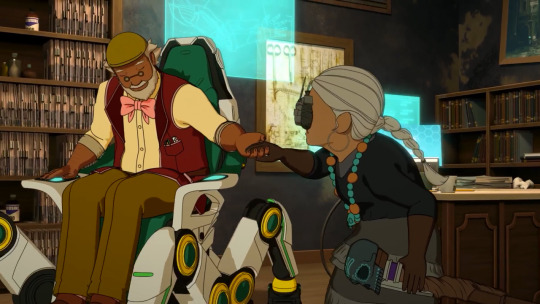
Perhaps it will come down to Ruby having to fight an infected Virus Penny 2.0. However I don’t think Ruby will be forced to kill Penny. I think a moment like this will boil down to what’s stronger---hardware and programming or the soul.
It was stated back in V2 that Penny is the first (and possibly only one) of her kind. The first artificial lifeform to produce an aura. As we know, aura is described as the manifestation of one’s soul. Penny is supposed to be a soul within the body of a machine. While her body may be synthetic, at her core, she is supposedly human or the closest thing to it.
And since the V7 opening hinted at love being a major theme for this volume, it makes me wonder if we’re going to get a potential moment where a mind-controlled Virus Penny tries to harm Ruby but in the end, it’s the strength of the profound friendship shared between both girls that ultimately allows for Penny to combat the virus corrupting her machine software with the love she feels in her soul for her dear friend. Y’know love conquers all.
I wouldn’t even be too surprised if it’s a case where Penny ends up sacrificing herself to put a stop to Watts’ tyranny. Like Penny uses her core to cause a chain reaction that obliterates Watts’ powerful virus.
Dr. Polendina mentioned in the first episode that the only reason he was able to fix Penny in the first place is because Atlas was able to salvage her core from Amity Arena. Penny’s core is obviously an important part to her. I’m assuming it’s the part of her that contains the soul that’s keeps her alive. So no matter how many times Penny’s body is destroyed, so long as her core is still intact, she can be brought back. Why mention that little detail at all if it wasn’t going to be relevant later, ey?
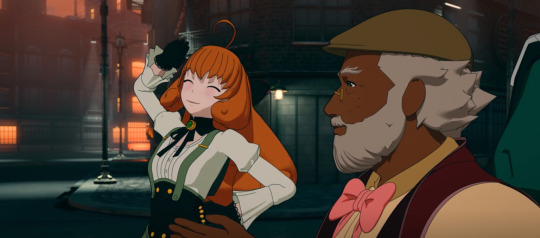
What if … Penny’s core does eventually get destroyed. If that gets obliterated, then Penny---or at least the version of her that Ruby knew and loved--- will be gone for good this time.
I feel like the V7 finale could set up for a Terminator II type of conclusion where the machine our protagonist has grown to know and love over the course of their story is forced to sacrifice itself for the greater good of saving our hero from a dark fate. I feel like should your headcanon be made reality in the canon, we’re likely to see Penny sacrifice herself on the grounds that this time, there’s no coming back.
I can imagine Penny’s core being used as the key to stopping Watts reign over Atlas and this time, Ruby is allowed to do what she couldn’t do back in Vale. Not only would she get to save Penny but she would also get to officially say goodbye to her friend and tell her how much she loved her before tearfully watching her give herself up for the purpose she was built to do---save the world.
That’s how I’m more seeing things going down for Ruby and this newly rebuilt of Penny for their shared storylines this season. As per usual, these are only my headcanons here and I can very well be very much wrong in my prediction. But nevertheless, for now, I’m leaving this thought and theory on the table.
Then again, I’ve also gotten ahead of myself here.
------------------------------------------------------------------------------------------------------------------------------------------------------------------------------------------
More Machine Than Man
Now that I’ve discussed how I figured Ruby and Penny’s story may conclude for V7, allow to me to voice my views on the build up to it.
As I’ve said, I feel very off about Penny being back. While I’m relishing in seeing her again, I also can’t feel a sense of this is too good to be true; y’know what I mean?
I feel like this is all a set-up. Like right now, both the audience and our main gaggle of heroes are left to believe that Penny had returned and she’s all good as new---almost like she never died at all, right?
But I feel like there’s a catch to that. I feel like at some point, in a later chapter of V7, Ruby is going to have her chance to spend some quality time catching up with Penny. At first, things seem pretty normal between them. They’re both laughing. Swapping stories…having a grand ole time with their heart to heart girl talk…only for Ruby to notice something quite off about Penny.
Like I have this scene imagined in my head. A scenario in which Ruby is supposed to head back down to Mantle to hang out with Penny P who’s finally have some free time to catch up with her old friend and desires to take Ruby on an official fun tour of Mantle---the nicer parts that is.
As a matter of fact, let’s say Penny invites the whole squad---JNPR_RWBY down for a night of fun and dancing down in Mantle with her and father. Pietro did mention in the first episode that he’s been working on shows that dance. Given his enthusiasm, dancing must’ve been one of Pietro’s favourite pastimes prior to losing function in his legs. So maybe, at some point, since the kids have all been working hard with their huntsmen duties and training, Pietro decides to treat them all to a nice of entertainment.
Imagine if …Pietro and Penny take the group to an old fashioned Mantlese Carnival which is basically RWBY’s version of Mardi Gras with a big parade of bands with nonstop musical entertainment.
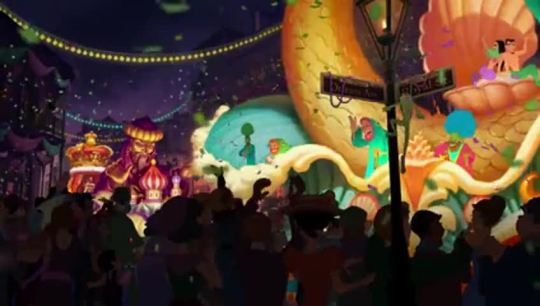

I was kind of hoping that our heroes would have reunited with Team FNKI while they’re in Atlas. But it doesn’t seem like they’ll be present at all for this season. Unless, it’s a case where our heroes run into them while out with the Polendinas.
Resuming my Mantlese Carnival idea, let’s say after the group finished watching the parade, the Polendinas lead them to an old-fashioned snazzy little joint whose taste in jazz music is as sweet as its food.
I couldn’t help but be reminded of jazz music and the blues by Pietro Polendina’s design and the way he talked. His sense of fashion is giving me mega New Orleans type of vibes. Like he walked straight out of the set for the Princess and the Frog.

Anyways, like I said, our heroes are treated to a night of music and dancing by the Polendinas but while out and about in Mantle, they also happen to run into none other than Neon Katt and Flynt Cole.

Like imagine the group enjoying a nice performance by a local jazz band in Mantle only to find out that one of the musicians is Flynt.
Neon is also there to either show Flynt support (as my headcanon is that the two are dating) or perhaps she’s part of the performance with him as a singer as she and Flynt deliver a sort of Jazz/Blues rendition of Neon’s classic theme. Why not, ey?
After briefly exchanging pleasantries and catching up with their ole pals from Vale, Flynt and Neon invite everyone to an underground Mantlese rave. So unfortunately for Pietro and Maria (who was his date/company for the night), the younglings end up ditching the old folk for a night of partying. Not that they minded. Even Penny was allowed to join the group at the rave.
So as promised since V2, Neon and Flynt take JNR_RWBY plus Oscar and Penny out partying. As a side note, I’m not sure if Oscar would even be allowed to set foot inside a club given his age as a minor. Like I can just imagine Oscar, innocent as ever like the country munchkin that he is, walking up to the club bouncer only to be immediately barred from entering for being both underage and looking the part. Like would you believe Oscar is actually his age given his short stature and baby face?
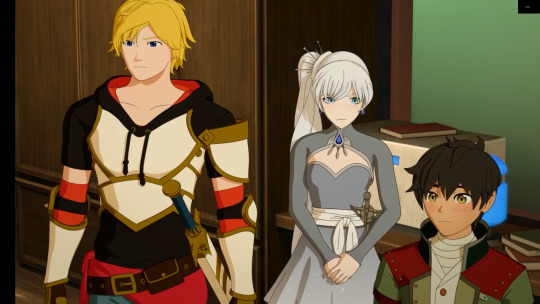
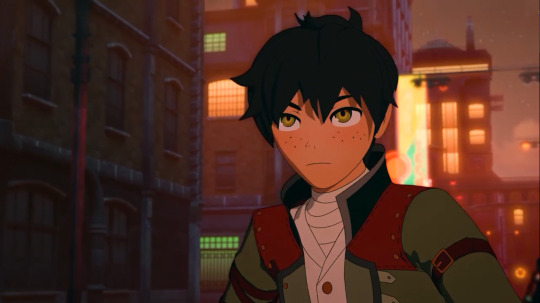
As a matter of fact, the only way I can see Oscar being allowed inside of a rave is if a) he faked his age by having one of Flynt and Neon’s friends hack into Atlas’ s system and alter his birth date by two years (since I’m imagining Atlas using electronic ID scans that instantly verifies a person’s personal records by just scanning them on the spot) or b) Flynt and Neon pulls some strings to have Oscar allowed in as they’re known regulars of the club. Why not?
So the group are out having a grand ole time, and while enjoying themselves Ruby and Penny sort of skedaddle for a bit up to a private place where they can just talk to one another. Since y’know…it’s been so long since they shared a chat since one of them was presumed to be dead and all. Anyways, it’s during their talk that Ruby noticed something peculiar about Penny’s behaviour.
She keeps recalling memories of times she and Ruby shared in excruciating detail. But that’s not the part that threw Ruby off. No matter how many times the Silver Eyed huntress attempted to deviate the conversation and get Penny to talk her more about how she’s been doing since what happened at the Vytal Festival, Penny kept reverting back to recanting the same stories.
The hunch I had in mind here is:
What if…Penny 2.0 is actually a copy of original Penny. Rather than being a soul mimicking human nature from within a mechanical body, it’s more a machine operating purely from memories that were transferred to it from its old former self.


When we first met Penny, while the implications of her being an humanoid were clear as day from the instant she first bumped into RWBY (I mean I certainly called that she was a robot from day one), you could also still tell that there was something remotely human in nature about Penny. I got that sense the first time Penny revealed to Ruby that she wasn't a real girl. You heard the strong tinge of genuine sadness in her voice as she said it which was what made her friendship with Ruby all the more pure. Their bond was wholesome and important to each other inspire of only knowing one another for a short space of time.
And when Penny died in V3, you didn't feel as if it was a machine being destroyed. You actively felt like a character---a real person died. We, as the audience, got to feel the same sense of sadness that Ruby Rose felt watching her dear friend die before her very eyes after failing to save her in time.
Ruby failed to protect Penny (and eventually Pyrhha too) which was what made her answer to Maria’s question in V6 all the more meaningful.
She wishes to master control of her Silver Eyes, not just for the sake of being able to vanquish the Grimm but for the sake of protecting the people who matter most to her---her friends and family. The people who love her as much as she loves them.
This also kind of presents another reason why I’m conflicted on Penny’s return. Penny being back all fixed and good as new as if the Fall of Beacon didn’t happen kind of puts a bit of a damper on Ruby’s trauma as a result of what happened. It’s one of those things that made me question why show Ruby suffering from flashbacks of her friends’ deaths just to have said friend return good as new.
As we saw during her ‘Indomitable’ moment in V6, thinking about Penny and her death caused Ruby to lose focus. Yes Ruby managed to summon her light to petrify the Leviathan. But not before using Jinn to buy her some time so she can concentrate and let’s also not forget that Ruby’s power didn’t work.
While she succeeded in petrifying the Leviathan, she failed to kill it. This to me was a clear indicator that Ruby hasn’t full mastered her unique power and still has much to grow. A detail that I was relieved the CRWBY kept since I never felt like Ruby’s indomitable moment was rightfully earned so it almost felt like a waste of a good moment, in my opinion
I’m probably in the minority here when I say this but I actually disliked Ruby’s Indomitable scene from V6. As I said, it wasn’t properly earned and that took me out of the whole moment.
Instead of watching Ruby go through an arc of learning to fully master control of her newfound abilities, struggling at first but also learning more about herself and her heritage in the process building up to this grandiose moment where she finally perfects her power.
Instead we spent two whole seasons with our little red rose being written to be rather neglectful of her eyes, never once further questioning its mysterious origins; not even when in the face of the very person who told the last person who first told Ruby about her eyes.
Ruby learnt about the Silver Eyes from Qrow during the finale of V3. Qrow, on the other hand, said he learnt about the Silver Eyed Warriors from Ozpin. Ruby had her chance to ask Oz for more on the Silver Eyes at any point during V5 or even V6. Instead the Writers have her question everything but her Silver Eyes…despite showing her using it again later in the season during the Battle of Haven.
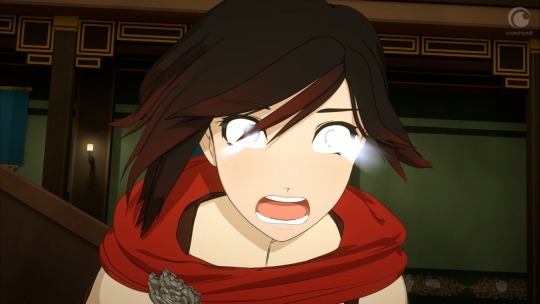
It is such a darn shame that Maria Calavera was only brought in for V6. I honestly feel like her character and role as Silver Eyed mentor to Ruby should’ve been better utilized as early as V4.
Instead I was left feeling that Maria’s presence in Ruby’s development was made irrelevant especially by the end of V6 when Ruby had her big brain idea to use her Silver Eyes on the Leviathan…despite having zero prior training. I don’t think that’s how progress is supposed to work?
And let’s not forget the fact that Ruby has only known Maria for only four days since the entirety of V6 (and the start of V7) only took place over the course of four days in RWBY’s timeline.
So yeah, Ruby’s Mastery of her Silver Eyes has much more groundwork to do and I have a feeling the Writers brought Penny back to aid with that

Did they necessarily have to though? No not really. As a matter of fact, Penny 2.0 unfortunately falls into the ball park of how the Writers brought back Neopolitan in V6 for me. While it’s nice to see Penny again, I didn’t honestly need her back especially since her death was framed in such a symbolic way to the plot in terms of how it affected Ruby’s character these past few seasons. Now I’m left questioning what the whole point of all of that was.
Listen, I’m not trying to imply that bringing Penny back was a terrible idea on the Writers’ part. I’m more saying, I don’t 100% buy into it. Not exactly.
I honestly feel there is going to be a catch with this. The Writers can’t have Penny’s death still affecting Ruby only to just magically have that trauma and mental block magically disappear now that she’s back in the picture. They’re not gonna do that, right?
They’re not gonna undo that big detail established in previous seasons, right? I mean…it’s not like they’ve done things like this before, right?



Nuh uh. Not buying it. Hence my theory on Ruby having a moment with Penny 2.0 only to realize that she’s not exactly all good as new as she was proclaimed to be.
Either that or it’s a case where even though Penny is back, Ruby herself can’t seem to look past the past.
She can’t seem to shake the haunting fact that she once saw her friend die before her very eyes because she failed to help her. Like I’d figure that that memory would still remain as a nightmarish lingering thought in Ruby’s psyche. Right?

Like imagine this scene. A scenario where Ruby and Penny are out exploring Mantle together, catching up only for Penny to be called back to the line of duty when another alert of Grimm attacking the city blares it ugly head. As Penny flies off to do her thing, Ruby follows her below on foot determined to help her out. When Ruby finds Penny, she arrives just in time to see her down a couple of Saybers from attacking a couple of fleeing civilians.
Ruby calls out to Penny. Penny, in turn, spins around to wave to Ruby. But while Penny is distracted greeting her friend, she is neglectful of one stray Sayber that suddenly comes in from behind and slashes Penny straight through the chest.
Ruby looks on in complete horror as Penny 2.0 is once again cut down in front of her; the nightmares of her decapitation at the Vytal Festival resurfacing. And for a moment, Ruby freezes on the spot. She doesn’t even react as the same Sayber charges at her.
But before the Sayber could get to Ruby, it’s killed before it could lay a bloody talon on her. As Ruby looks up slowly from her daze at her saviour , she sees that it was Penny. In spite of her damage, Penny was still functioning enough to protect Ruby.
Let’s say, for the sake of the scene, the rest of the heroes---JNR_WBY plus Oscar were down in Mantle too and overheard all the commotion from the emergency alarms; all seven huntsmen and huntresses arriving at the scene to aid with the rescue.
Let’s say the others had seen what happened to Penny and immediately came to her side to quickly gather up her severed parts to take her immediately to Dr. Polendina so he could repair his daughter.
As the others handled Penny, let’s say…Oscar approaches Ruby as he noticed the disturbed expression on her face. Oscar urges Ruby on the matter of them taking Penny to her father as quickly as possible. At first, Ruby reacts like she didn’t hear Oscar; apparently too lost in her own wild thoughts. It wasn’t until Oscar gently touched Ruby’s shoulder did she finally stir out of her stupor. Long story short, the heroes manage to get Penny 2.0 to Pietro in time.
After studying her injuries, Pietro reports to everyone that Penny was going to be fine. She may be off duty for a couple of days given that he’ll need time to repair her.
But beyond that, Pietro assured the group that Penny was going to make a speedy recovery; much to the relief of the heroes. But in spite of hearing the good news, this doesn’t serve to uplift Ruby’s mood and her bothered expression of deep concern is still apparent on her face. Even as JNPR_RWBY depart from the Polendina residence to return up to Atlas.
As the group look to head back home, Oscar is the one to take notice of Ruby’s awkward silence.
I say Oscar of all people rather than her teammates or Yang since it’s been highlighted before that when Ruby is feeling pressured or looks distressed in some shape or form, Oscar is quick to pick up on that.

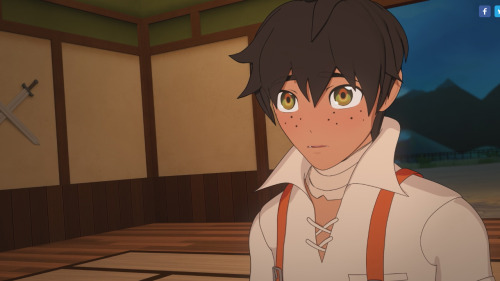
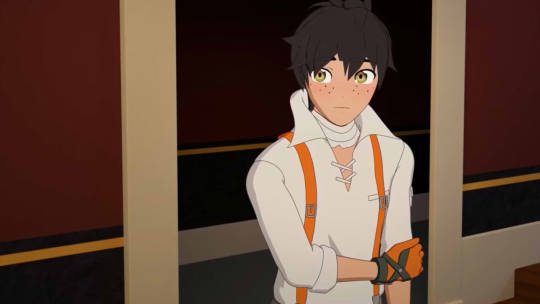


He’s also been shown to act out on trying to help Ruby in this type of emotional scenario. This is why should we ever get a moment like this in the canon, I can picture it being another prime chance for the Writers to show Oscar being an emotional crutch for Ruby.

If a scene like this ever comes to pass in the series, the way I see it going down is Oscar confronting Ruby again about Penny and the two sharing another heart to heart moment where he gets her to open up about her true feelings. I’ve been itching for another V5 Dojo-esque scene between the Rosebuds.
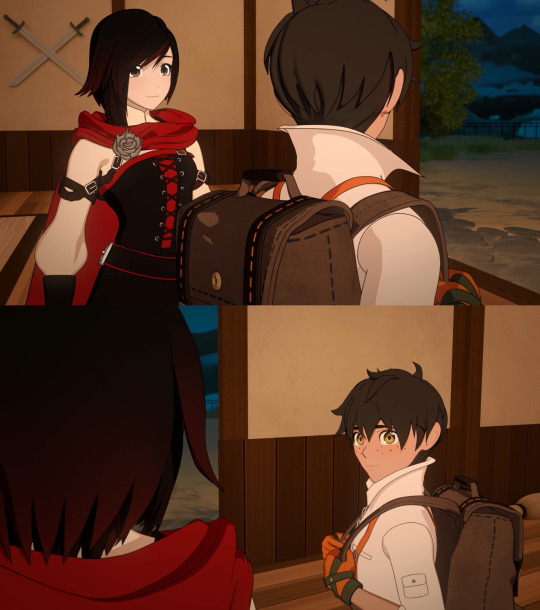
I’d love to see another example of Oscar helping Ruby through another emotional rut; particularly if it involves Penny.
------------------------------------------------------------------------------------------------------------------------------------------------------------------------------------------
So to conclude…
I guess the main point I’m really trying to get at here with this musing post is that I don’t believe Ruby’s arc revolving around her grievances about Penny’s death is over. Even with her being back in her life.
It can’t be. Just because Penny was repaired and has returned doesn’t instantly erase the fact that she did die nor does it erase Ruby’s memory and clear trauma over it. At least, I hope that’s not how the Writers are going to portray it. Ruby’s thing is that she sees Penny as a real girl. She sees her as a person. But Penny isn’t entirely a real person.
She possesses a soul of her own, yes (and I’m curious to learn the origins of said soul) but she’s also a machine. Her body is fake but at her core, she is a living being. Sort of---really need an origin episode on how Penny was created and where Atlas and Ironwood got the soul that’s a part of her.
Did it come from the Relic of Creation? Was Penny an unexpected by-product of the Relic’s power; brought to life by an experiment tested by Ironwood using the Relic of Creation?
Is the Relic of Creation the RWBY equivalent of the Blue Fairy from Pinocchio? Is the being of the Relic of Creation inspired by the Blue Fairy from Pinocchio?
Who knows? These are all questions I’m looking forward to this season answering for me.
But in the meantime, in regards to Ruby’s bond with Penny, We got to see Ruby grow to care for Penny as a person and what’s interesting to note is that Ruby has always valued Penny as more human than machine.
Keeping that in mind, picture if part of Ruby’s story with Penny for V7 is her leaning to accept that Penny isn’t a real person.
This is why I like my theorized scene of having Ruby witness Penny 2.0 being cut down again; highlighting she’s still not over what happened at Beacon. Imagine if that creates an issue for Ruby where she actively feels uncomfortable at the thought of losing Penny time and time again since she can’t handle watching her friend getting destroyed in spite of the fact that she’s a machine that’s built to protect humanity.
I know this concept probably sounds rather farfetched based on how I’m describing it. However, that’s how I’m choosing to look at it; for now. Perhaps the story for this season might change my mind on that. We’ll see.
Anyways, that’s all I have to say on this subject matter for today. For the most part, I hope I managed to answer your question, Jade. As usual, please let me know if I did. I’m always open to hearing other FNDM fam members thoughts on my thoughts on my thoughts.
Similar to you, this squiggle meister is also left pondering why the Writers’ brought back Penny. It’s actually kind of sad that I have to question it. If I wasn’t so skeptical over the CRWBY Writers’ writing decisions given their recent track record then I wouldn’t be questioning this decision so much.
Right now my theories are my best bet at understanding why this decision was made for the plot but that don’t mean that that will be the case in the canon. I’m praying there is a good narrative reason for Penny’s return and that it wasn’t done as a gimmick to hype up the fans for the new season---y’know bringing back another fan favourite character just because they thought it would be quote, unquote, ‘cool to do’.
I didn’t like that that was the rationale for Neo’s return, as mentioned in the V6 DVD Commentary, and I’d be equally peeved if that was the rationale for Penny’s. Then again, maybe I’m getting too ahead of myself here. We’re only one episode into V7 so let’s not jump the gun. Let’s just be patient and wait and see what the rest of the season brings, ya?
Until then, hope you at least enjoyed my new musing post.

More Squiggles’ RWBY Content

~LittleMissSquiggles (2019)
#rwby#penny polendina#ruby rose#oscar pine#rwby theories#rwby volume 7 theories#rwby volume 7 spoilers#rwby volume 7#rwby musings
36 notes
·
View notes
Text
Well, as I am a very rational person and I like to find the meaning behind names and stuff, I thought it would be fun if I tried to find some possible meanings behind Don’t Starve character’s names. Below the Keep reading there is the result. Enjoy.
From the base game
Wilson: "Son of the protector". It also refers to his final fate in Don't Starve, where he becomes Maxwell/William Carter's successor by taking his place on the Nightmare Throne. But other than that, we all know why this name was chosen.
Percival: It has many meanings: according to various sources, it could mean "hero" (in reference to the Arthurian Percival), "he who pierces the valley", "hard steel" or "destroyer". Wilson Percival Higgsbury is the main character of Don't Starve and therefore the "hero", he wants to change the world with the power of his mind (he wants to "pierce the valley"), he is determined (his will is made of "hard steel"), but his attempts end in tragedy, making him a "destroyer" in a sense. 10/10
Higgsbury: It doesn't exist outside Don't Starve world, but we can try to understand the underlying meaning behind it. Higgs is an early diminutive of the name Richard (Old English is that odd), which means "powerful ruler"; it is also a reference to the "Higgs mechanism", a Standard Model of particle physics to explain the generation mechanism of the property "mass" for gauge bosons. "Bury" is a common suffix in English surnames meaning "fortified place". Therefore, "Higgsbury" means "fortified place of the powerful ruler" with a pinch of physics thrown in. That is a sum of all we already said about this character.
Willow: This name reflects the qualities of the willow tree, meaning "slender, graceful and lithe (flexible and resilient)"; according to other references, it can also mean "freedom", "resolute" or "peaceful". Other than that, in the past the name Wilhelmina was sometimes misspelled as "Willow Mina", which gives it the meaning of "willing protector".
Willow is my favorite character in Don't Starve, and one of the reasons is that, banally, I like the name "Willow" ever since I heard it for the first time in "Buffy the Vampire Slayer". This name has no apparent correlation with her character, as it is usually associated with water, calm and peace and Willow is nothing like that. However, the willow tree is also flexible, resilient and it can thrive in harsh and hostile environments and our Willow reflects these qualities even if she is not using fire. The misspelling of "Wilhelmina" can also be a possible origin of her name, as it was pretty common to spell words and names in a wrong way in the past (creating interesting variations from the original name, just like "Richard becomes Dick, and Dick becomes Higg" like seen above). And if you are still not satisfied, there is the meaning of Willow among Bach Flowers, a brand of homeopathic remedies used to positively affect emotions. Willow Bach Flower is used to help the bitterness caused by adversity, which often leads to destructive behaviors if left untreated, which is a perfect description of Willow's mental state at the beginning of Don't Starve. (And I found out about them just because I was looking for natural remedies to keep my pets calm during a long car drive. Life is amazing, eh?)
Wolfgang: "Travelling or advancing wolf". It is just appropriate for the strongest character in the game.
Wendy: This name became popular thanks to the novel "Peter Pan" with the meaning of "friend"; it is also common as a pet name for Gwendolyn, which means "fair-skinned" or "blessed". Wendy is a blonde, fair-skinned girl blessed by having the power to summon her late twin's ghost to protect her from harm.
Abigail: "Father's joy", or "she who gives joy". Abigail is one of the few people able to make Wendy feel some joy after her own demise. It could also be a clue of the fact that Abigail was the older twin and the original cause of joy for her parents, and that Wendy's birth immediately after was unexpected (at the time it was impossible to determine if a woman was pregnant with twins). Another possible meaning of the name is "a lady's maid" because it was the name of a maid in the play The Scornful Lady by Beaumont and Fletcher. Just like Abigail became Wendy's protector/minion after her own death.
Lillian: It's Abigail's second name and it means "pure and innocent like a lily", which reflects her being dead when she was still a child, therefore when she was still pure and innocent. According to other sources, it might be a diminutive for the name Elizabeth, which means "my God is an oath", which reflects her role as Wendy's sworn protector. It might also be a fusion of the names Lily and Ann, which mean respectively "blossoming lily flower" and "grace".
WX-78: It follows the name convention of Wagstaff's main inventions (radio PR-76, gramophone MD-77). According to the serial number they were among his last creations before Wagstaff reached the Constant.
Wickerbottom: It's her last name and it doesn't seem to exist outside of Don't Starve world. However, a possible meaning can be found by looking for the etymology of "Bottom", which gives her surname the meaning "from the wicker valley". It is interesting to notice that wicker is usually made of willow, a tree commonly associated with witches, which is appropriate for one of the strongest magic users in the game.
Woodie: More commonly spelled Woody and a common diminutive for Woodrow, it means "from the cottages in the wood" or "row of houses by a wood". It is actually a pun about him being a woodcutter.
Lucy: "Shining light". Wait a minute...
Wes: Also a diminutive for Wesley, it means "from the west meadow". (...)
Maxwell: It can mean "from Maccus's pool/Magnus' spring/Mac's well"; it can also mean "capable". The name was chosen as a reference to the thought experiment of the "Maxwell's Demon" created by James Clerk Maxwell in 1867 as a hypothetical violation of the second law of thermodynamics.
William: It means "vehement protector". It was possibly chosen to further Maxwell's connection to Wilson.
Carter: "Cart maker" or "transporter of goods by cart". Maxwell made the Constant livable again thanks to his experiments and then he transported in there new people to use them for his plans.
Robert: "Famed, bright, shining". He was a famous inventor before he went missing.
Wagstaff: "He who brandishes the staff". It was usually used as a reference to a law officer during the Middle Ages and his quotes in the game seem to suggest that he would be more than happy to follow Their will, no matter how evil or dangerous it could be.
Charlie: "Free person", "strong and vigorous", "free thinker". She fully shows to live up to her name in Don't Starve Together.
From RoG
Wigfrid: It is clearly a stage name. It could have two possible meanings: the first one is that it is just the name Sigfrid spelled with a "W", which would give the name the meaning of "victorious peace"; even if it is usually used as a male name, it can be used as a feminine name too in some countries of Northern Europe. The second possible meaning is that the name was chosen for some assonance with the original name of the actress, and taking into account the theory that "Wigfrid and the unused character Winnie are one and the same", it could mean that the real name behind "Wigfrid" might actually be Winifred, which means "peaceful" or "blessed peacemaking". And I am weirded out to associate "Wigfrid" to "peace" as much as you are, but like Latins said, "If you want peace, prepare for war". Her character just took it a bit too literally.
Webber: It is probably his surname, which means "weaver". But we all know why this name was chosen, so let's move on.
From Shipwrecked
Walani: I could not find its direct meaning online, so I tried to recreate it by searching for its parts. It could either mean "heavenly canoe" (and then it is a reference to her surfing ability) or "heavenly sound (of chord instrument)" (and then it is a possible reference to her being voiced by an ukulele). Walani is also an African word meaning "shining". Or it could be a diminutive of the name Walanika or Walanyka, the Hawaiian form of the name Veronica, which means "true image".
Warly: Normally spelled Warleigh, it means "from the weir meadow". And it makes another French speaking character associated with meadows for some reason.
Wilbur: It seems to have various meanings. It could mean either "dearly loved stronghold", "willful and bright" or even "wild boar". Which is ironic for a poop-throwing monkey, but it makes sense for a king with a higher intelligence compared to the other monkeys.
Woodlegs: I refuse to explain this one.
From Hamlet
Warbucks: Despite this surname is pretty common with the alternative spelling Warbuck, its original meaning was impossible to find (that probably is "from the buck's weir" by the fact that it begins with the prefix "War" which seems to mean "from the weir"). Thanks to the "Daddy Warbucks" cultural reference, it could just be meant as "rich benefactor", and he saw himself as one for the pig society for sure.
Wilba: It is a not so used anymore name with a lot of meanings, which includes "little bear", "winsdom and knowledge", "understanding" and "from the wine country". It is also used as a feminine form of Wilbur. Her name's
many meanings refer to her being the pig princess (and therefore "the future wise and benevolent queen") of the opulent kingdom of Hamlet and her being affected by Lycanthropy.
Wormwood: He owes his name to Artemisia Absinthium, an ornamental plant which is also used as an ingredient in some alcoholic beverages.
Maybelle: Variation of the name Mabel, it means "lovable".
Dorothea: "Gift of God"
Wheeler: "Wheel maker"; other sources list its meanings as "lucky warrior" or "prosperous hero". For sure luck has an important part during her survival adventures, and her Navigadget can make her prosperous pretty quickly in Hamlet's world...
From Don't Starve Together
Bernie: Diminutive of Bernard, it means "bear". He is a teddy bear and his name sounds similar to "burning" in a reference to the fire-related abilities of his owner Willow.
Ashley: "Lives in the ash tree meadow". Her name contains the word "ash", referring to Willow's fire powers.
Winona: "Firstborn/eldest daughter". She is Charlie's older sister. Is any other information needed?
Wortox: Wortox is a totally original name (if you ignore the existence of a Swedish Death Metal band from the late 80s) which seems to have its root in the word "wort". "Wort" can have three different meanings: the most common of them is "unfermented beer". Beer is a beverage associated with demons because of its intoxicating effects. The second meaning derives from "St. John's wort", a flower known for its antidepressant effects and considered a magical plant able to repel witches and demons in the Middle Ages as a result. The third one comes from the Old High German, according to which "wort" means "word/verb", which is a callback to the concept of "Logos". "Logos" is a recurring theme in western philosophy, with so many meanings it would take a lot of time to explain every single one of them, so let us all thank Wikipedia for existing (https://en.wikipedia.org/wiki/Logos). The various metaphysical meaning of the term can be roughly summed up as "Logos is what exists in between the physical world and the metaphysical world". The word "logos" can be found in the Bible too, translated as "word" in English... and as "wort" in German. This kinda makes one of the possible translations of this word appropriate (and ironic) to name a demon who follows a metaphysical theme: one word, two meanings with more or less direct references to demons and one meaning with a metaphysics reference, add a final "-ox" and you got a cool name. GG Klei.
(Now let me go put my head under some iced water because my brain is overheating thanks to my attempt to explain the last point about Wortox...)
Wurt: Its meaning changes according to the sources. As an alternative spelling of the name "Wurth", it means "worthy", possibly referring to her being a Mermguard. As a variation of "Wirth", it means "innkeeper" or "head of the family", and her purpose is to bring back the Merm King as the ruler of the Constant. As for the possible meanings of the word "wurt" itself, in Old High German it was "fate, destiny", in Old Saxon it was "plant", while in Low German it was "man-made hill or elevation", referring to a construction system designed to protect structures and buildings from flooding (just like the stilt houses that inspired the constructions Wurt is able to create for her fellow Merms).
Walter: A German masculine given name widely spread in Europe (and in the United States during the last century), it means "ruler of the army" or "powerful army".
Woby: It is apparently a surname which was first found in Lincolnshire as a variation of "Welby", which means "from the farm by the spring/stream".
Wanda: It is a Slavic origin name which means "from the Wend (Vandal) tribe", "young tree" or "stem". It became popular during the eighth century thanks to the daughter of King Krak, the legendary founder of Krakow. It was introduced in the English language in 1883 thanks to the eponymous novel by Ouida with the meaning of "wanderer".
#don't starve#don't starve together#name meanings#some of them were impossible to find so I had to improvise
8 notes
·
View notes
Link
Auri has a special place in my heart.
I made a playlist for her with songs, that remind me of her.
If you want to know more about the reasons why I chose those specific songs and pieces of music, you can read the explanations under the cut.
Enjoy.
In the following parts I will talk about the pieces I chose and the reasons why I think they fit. Sources are most often provided. Obviously this part contains spoilers about the character Auri from the king killer chronicles by Patrick Rothfuss and I will quote from the 2014 edition of the slow regard of silent things (tsrost) as well as from the tenth anniversary edition of 2017 of the name of the wind (tnotw).
Precious joy:
The piece of music “precious joy” was heavily inspired by a piece of bach called “Jesus bleibet meine Freude” (translation from the german: Jesus remain my joy). It was played by the band “the modern jazz quartet” and can be put into the genre of jazz.
In this piece elements of jazz and bachs style of playing mix in an unique way.
This fits Auris character in many ways.
Bachs style, built on a rigorous system of rules (https://en.wikipedia.org/wiki/Johann_Sebastian_Bach#Four-part_harmony, https://en.wikipedia.org/wiki/Johann_Sebastian_Bach#Structure,_lyrics) clashes and mixes with the style of modern jazz, which in many ways represent a detachment from the current rules of music.
This is similar to Auri, who is detached from society at large and still acts according to rigorous rules.
The melody also fits to Auri. It is written in G-major and while pieces of music written in major often only sound happy, this piece does not. The melody sounds not just happy, but also has parts where it sounds melancholic and sad/somber. The mix results in a often bittersweet sounding melody.
The feelings that are conveyed fit quite well to Auri, who seems happy at many points, but has also her sad and melancholic moments (page 77 of tsrost, “On the third day, Auri wept.”).
Concerto RV 156 in G minor: I Allegro:
I picked this piece mainly because of the sweetness of the melody.
It is written in G minor and while “precious joy” had notes of sadness even though it was mainly happy, this piece has notes of happiness even though it is mainly melancholic.
It symbolizes the aspects of Auris character that are often hidden from Kvothe, who sees her mainly as happy (page 370 of tnotw, Auri was scrupulously clean and full of joy.).
Prophecies:
The piece of music “prophecies” was written by Phillip Glass. It is an example for minimalistic music. The music was written for the Movie “koyaanisqatsi”.
The movie Koyaanisqatsi, whose title means life out of balance in the Uto-aztecan language Hopi, is an experimental film, that shows footage of nature next to footage of human made technology and structures. The directeur of the movie stated, that the interpretation of the movie should and can only be done by the viewer itself (https://en.wikipedia.org/wiki/Koyaanisqatsi#Meaning).
Leo Hickman from the guardian stated how many people interpret the movie. His statement is that the movie is “a transformative meditation on the current imbalance between humans and the wider world that supports them”.
This fits nearly perfectly to Auri, who is obsessed with finding balance and who sees other humans as a big factor, which destroys balance (page 47 of tsrost “they would be coming, all hard boots and arrogance and not one bit of proper knowledge of this place”, page 51 of tsrost “it led to the same thing. Upset. Folk finding keys. Folk opening doors. Strangers in her underthing, shining their unseemly lights about. Their smoke. The braying of their voices. Tromping everywhere with hard, uncaring boots. Looking at everything without a single thought of what a look entails. Poking things and messing them about without the slightest sense of what was proper.”)
This interpretation holds true even if we ignore the background of the movie and only listen to the one piece of music, because Koyaanisqatsi which again means life out of balance is sang in the second part of the song.
The minimalistic style that is used also has elements, that fit Auri, who lives a simple life full of repetition, which fits to the style of minimalistic music.
I chose this piece and not another from this movie, because the first part of the piece has a bright melody, which fits Auri more than just the darker parts of the music.
Particles, Island songs VI:
This song represents the melancholy of Auri. While “precious joy” and “concerto in G minor” had elements of sadness, this song represents that aspect fully.
The melody is very melancholic in a soft way, which fits to Auri.
In this song the lyrics have also an important role, that makes the song fit very well to Auri s character.
As example the lines “And i try to keep the balance right. And I try but it feels like wasted time” represent both Auris struggle with the chaotic world around her and with her own chaotic emotions.
All the rowboats:
I chose “all the rowboats” mainly because the lyrics fit very well to Auri.
In this song the artifacts in a museum are depicted as having a will on their own.
The whole song sings from the injustice of the imprisonment of the “masterpieces” in this museum, which the singer once calls a public mausoleum, which is filled with the living dead.
In the refrain the singer sings how she feels pity for the violins, who forgot how to sing.
This general sentiment fits very well to Auri, who also thinks of artifacts as having a will on their own. It is not absurd to think, that Auri would also think, that the display of things only for the sake of being seen by humans, was deeply wrong.
The melody of this song is not only sad, but also angry. Anger and Auri is not often connected, but there are some instances, when the text depicts her as angry (page 51 of tsrost “Auri realized her fists were knots of knuckle white.”, page 84 of tsrost “then her mouth grew furious. Her eyes went hard. […] Hot from bakery, and all asweat with rage and the unrightness of it all, Auri turned and stormed away…”, page 92 of tsrost “…and stuffed the blanket angrily into the wine rack.”). It is only fair to have a piece of music, that symbolizes that side of Auri in this playlist.
Variationen zur Gesundung von Arinuschka (translated from german: variations for the healing of Arinuschka):
This piece of music was made by the estonian composer Arvo Pärt, who invented the Tintinabuli style, which is a minimalistic approach of and to music.
His music, even though it sounds simple and is often not difficult to play, is the result of rigorous rules through which the piece of music gets constructed.
“I have discovered that it is enough when a single note is beautifully played. This one note, or a silent beat, or a moment of silence, comforts me.”
This is a direct quote from Arvo Pärt and it shows, that his relationship with music is different than the one other artists have.
His music lives through silence and careful slow playing of perfect notes.
A lot of the pieces, that Arvo Pärt wrote, remind me of Auri. I chose this specific piece, because it not only has bright and not only dark parts, but parts, where the two mix.
Its bright parts also include parts, where the music sounds light and amused and childlike.
All of those parts are important to Auris Character.
Auri is seen as light and childlike by Kvothe, but gets heavily influenced by feelings of sadness and anxiety.
The style of the music is also very important. Like the Tintinabuli style Auri also acts according to rigorous rules.
Like the Tintinabuli style her life is simple and has a lot of routine and repeating parts.
Like the music of the Tintinabuli style, she also lives and acts on her environment through silence and careful slow perfect actions.
Year of the dragon:
Year of the dragon is from the album “enjoy your rabbit” by Sufjan Stevens and was released in 2001. It fits the genres glitch, electronica and IDM.
Year of the dragon is different from the other pieces of music on this playlist. It is fast, seems chaotic, loud and is shockingly electric.
I was unsure at first, if i should put it on this playlist, but i think it fits Auri.
For many the piece is a lot in the first hear through. It seems very chaotic and at some times it does not even sound like music.
At a second or third hear through, some of the chaos of the tones start to vanish. monuments of sound bloom out of the chaos.
For me this piece of music does not sound like chaos anymore.
Every moment is wanted. Every tone masterfully placed.
A thick tapestry of sound is made and the more you listen the more patterns can be seen.
I think Auris life is similar. To the outside observer her actions seem weird and chaotic. But they are not.
I also think, that Auri sees the world in that way. Everything seems chaotic at first, but there are ways the world should be. Patterns that should be followed.
I also chose this song because of the power of some of the melodic patterns.
The main example for this is the part in the middle, where the background base starts to descend in heavy pulses.
This is also symbolic for Auri.
Many see Auri only as the sweet childlike figure that Kvothe also oftentimes only sees.
This is not the big picture.
For people that have read the slow regard of silent things it is obvious, that she is more than just a childlike figure.
She probably endured terrible things and something changed her drastically, but she is still more than just a child.
She knows secrets that few know. Not just about the underthing, which she discovered. Not just about alchemy which she studied under master Mandrag. No. She knows about the world and how the world works in a way, that we only really know about Elodin and maybe Magwyn.
She is Auri and under her will all things bend to please her.
14 notes
·
View notes
Link
A bit of sad news here. Tania Mallet played Tilly Masterson, the sister of Shirley Eaton’s Jill (the woman infamously painted gold after being murdered by Oddjob) in Goldfinger. Sadly, her character was also murdered by Oddjob not long after encountering Bond, who interferes with her attempt at assassinating Auric Goldfinger out of revenge for her sister. Although only on screen for a relatively short time (really just two major scenes), Tilly really stood out. For one thing she was the first notable “Bond girl” to not have any sort of romance with Bond (not counting female villains I don’t think we saw that again until Olga Kurylenjo’s character in 2008′s Quantum of Solace), sometime emphasized by her interrupting 007 before he’s able to utter his famous “My name is Bond, James Bond” intro. And her revenge-driven character arc predated that of both Barbara Bach’s Anya in 1977′s The Spy Who Loved Me and Caroline Bouquet’s Melina in 1981′s For Your Eyes Only (though there’s a bit of this involving Claudine Auger’s Domino in 1965′s Thunderball, too).
Sadly, other than a guest appearance on The New Avengers in the 1970s, Goldfinger was Mallet’s only major film appearance. She was primarily a fashion model, and preferred it to acting (though she did apparently try out for the role of Tatiana in From Russia with Love). Even though she never became as well-known in film like other women in the Bond franchise, she played a key role in making Goldfinger, to this day, one of the best Bond films ever. RIP
1 note
·
View note
Text
Act 1 (71-80)
Everybody loves a clown, so why don't you?
Everybody laughs at the things I say and do
They all laugh when they see me comin'
But you don't laugh, you just go home runnin'
Everybody loves a clown, so why can't you?

Page 71 - John: Go in the study.
71. Agh, so many more details. More FUCKING CLOWNS. Top hat, bowler(?) hat, umbrelly, another pipe, cards, posters I’m sure I’ll get a closer look at soon, piano, safe. DAD is apparently a musician, a smoker, a delinquent, a dapper gentleman. With something to hide. And a FUCKING CLOWN fetish.
72. Are the individual cards significant, divination-wise? I’ma leave that rabbit hole alone — squinting at the screen is slow; if it’s important I imagine someone else has dug it up, and I’m still Forging. Serious Jester magazine...magazines, like CDs, were still a thing. Why does Dad have a CAPTCHALOGUE CARD? Just the nonsensical resource-distribution of video games? (”Good thing someone randomly dropped these healing potions/ammo clips/mithril ores/doohicky-widgets at algorithmically generated intervals!”) Or is DAD also playing the game on some level? And hoary old CAN OF PEANUTS prank subverted by peanut allergies? Or vice versa?
73. Swap magician’s hat for bowler(!) hat — oh, it was supposed to be distinguished, not dapper. My bad. (Did he have to UNMERGE the hat from the glasses before he could schwitcheroo, or does he have a secret SWAP command now?)
74. “Combine second pipe with clever disguise” — another command that John declines. What blurry level are we on, and whose free will is in operation? [Glad he agrees with me on the taste of tobacco. Blecch.]
75. Examine stray card (and Serious Jester cover? I examine; naught I make heads or tails of for the mo). [Wouldn’t an Irreverent Jester/ure be more fitting? On second thought, no, I am foreboding that in this 'verse jesting and clowns are going to be SERIOUS FUCKING BUSINESS.
76. Argh! Trying to add a CAPTCHALOGUE card to his deck, and CAPTCHALOGUES it onto another card instead. Yay, I love me some recursion! (if you do too, I recurse you with the book Gödel, Escher, Bach yer welcome.).
77. Apparently John's a musician too — he plays a Haunting Piano Refrain. How many times have I heard this Haunting Piano Reframed? (I don’t know because right now my secondhand Homestukmusik exposure via Myster all blurs together....but I expect that will change over time too, as I get inexorably drawn deeper and deeper into the vortex....)
78. More random meandering — John deals a game of 52 pickup for himself, playing the fool for an audience of JESTERS. (Maybe he will end up being the THE FOOL in some sense?) And he’s allergic to their scorn. Because they're a Peanut Gallery. (”Scorn warriors! Lend me your ears!”)
79. “John: Attempt to leave the house.“ Interesting, that the command itself sheds doubt on his ability to do so. But he's distracted by TV commercial — EctoCooler for the EctoBiologist in his Slimer shirt.
80. Oh, he actually does leave the house, still in disguise. He's not Homestuck after all! [Then who is?] (Though technically, most of us (with yards that is) still think of our front yard as part of our home — we would consider ourselves 'home' if we were there, at least.) Not much new to see out here. Budding leaves and flours (eh, tripping fingers make accidental baking pun, I’ll allow it), a telescope on the balcony.
My goal for today is to get to page 126, to get a full day ahead of the Great Re-read that starts tomorrow, so.... Lefty-o-yo-yo, on we go...
2 notes
·
View notes
Text
Blog No. 6
Group Performance of the Kings of Classical Music (Haydn, Mozart, Beethoven)
Group Mates: Eva Cuenza, Mareal tumanda, joshua Gramaje, Ruzzel Santos, and Trixie Dayrit
Franz Joseph Haydn, (Born March 31, 1732, Rohrau, Austria—died May 31, 1809, Vienna); Austrian Composer
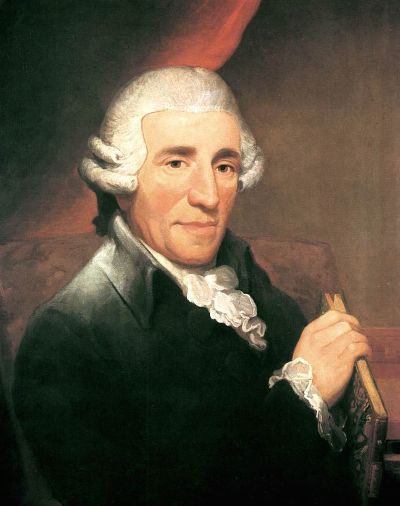
Over the course of his 106 symphonies, Austrian composer Franz Joseph Haydn became the principal architect of the classical style of music.
Synopsis
Franz Joseph Haydn was among the creators of the fundamental genres of classical music, and his influence upon later composers is immense. Haydn’s most celebrated pupil was Ludwig van Beethoven, and his musical form casts a huge shadow over the music of subsequent composers such as Schubert, Mendelssohn and Brahms.
Early Life
Franz Joseph Haydn was recruited at age 8 to the sing in the choir at St. Stephen's Cathedral in Vienna, where he went on to learn to play violin and keyboard. After he left the choir, he supported himself by teaching and playing violin, while studying counterpoint and harmony.
Haydn soon became an assistant to composer Nicola Porpora in exchange for lessons, and in 1761 he was named Kapellmeister, or "court musician," at the palace of the influential Esterházy family, a position that would financially support him for nearly 30 years. Isolated at the palace from other composers and musical trends, he was, as he put it, "forced to become original."
The Mature Artist
While Haydn rose in the Esterházy family's esteem, his popularity outside the palace walls also increased, and he eventually wrote as much music for publication as for the family. Several important works of this period were commissions from abroad, such as the Paris symphonies (1785-1786) and the original orchestral version of "The Seven Last Words of Christ" (1786). Haydn came to feel sequestered and lonely, however, missing friends back in Vienna, such as Wolfgang Amadeus Mozart, so in 1791, when a new Esterházy prince let Haydn go, he quickly accepted an invitation to go to England to conduct new symphonies with German violinist and impresario Johan Peter Salomon. He would return to London again in 1794 for another successful and lucrative season.
Already well known and appreciated in England, Haydn's concerts drew huge crowds, and during his time in England the composer created some of his most popular works, including the "Rider" quartet and the Surprise, Military, Drumroll and London symphonies.
Later Years
Haydn returned to Vienna in 1795 and took up his former position with the Esterházys, although only part-time. At this point, he was a public figure in Vienna, and when he wasn't at home composing, he was making frequent public appearances. With his health failing, his creative spirit outlasted his ability to harness it, and he died at age 77.
Haydn is remembered as the first great symphonist and the composer who essentially invented the string quartet. The principal engineer of the classical style, Haydn exerted influence on the likes of Mozart, his student Ludwig van Beethoven and scores of others.
Works
Haydn is credited as the 'father' of the classical symphony and string quartet, and also wrote many piano sonatas, piano trios, divertmenti and masses, which became the foundation for the Classical style in these compositional types. He also wrote other types of chamber music, as well as operas and concerti, although such compositions are now less known. Although other composers were prominent in the earlier Classical period, notably C.P.E. Bach in the field of the keyboard sonata (the harpsichord and clavichord were equally popular with the piano in this era) and J.C. Bach and Leopold Mozart in the symphony, Haydn was undoubtedly the strongest overall influence on musical style in this era.
The development of sonata form into a subtle and flexible mode of musical expression, which became the dominant force in Classical musical thought, was based foremost on Haydn and those who followed his ideas. His sense of formal inventiveness also lead him to integrate the fugue into the classical style, and to enrich the rondo form with more cohesive tonal logic, (see sonata rondo form). Another example of Haydn's inventiveness was his creation of the double variation form, that is variations on two alternating themes.
Structure and character of the music
A central characteristic of Haydn's music is the development of larger structures out of very short, simple musical motifs, usually devised from standard accompanying figures. The music is often quite formally concentrated, and the important musical events of a movement can unfold rather quickly. Haydn's musical practice formed the basis of much of what was to follow in the development of tonality and musical form. He took genres such as the symphony, which were, at that time, shorter and subsidiary to more important vocal music, and slowly expanded their length, weight and complexity.
Haydn's compositional practice was rooted in a study of the modal counterpoint of Fux, and the tonal homophonic styles which had become more and more popular, particularly the work of Gluck and Carl Philipp Emanuel Bach, of the later Haydn wrote 'without him, we know nothing'. He believed that the search for an appropriate melody was essential to the creation of good music, and carefully constructed his around countrapunctal devices, so that it could be overlayed with itself in a variety of ways, and the fragments could be worked with individually, and still retain some degree of unique character.
Haydn's work became central to what was later described as the sonata form, and his work was central to taking the binary schematic of what was then called a 'melodie'. It was a form divided into sections, joined by important moments in the harmony which signalled the change. One of Haydn's important innovations, one which was adopted by Mozart and Beethoven, was to make the moment of transition the focus of tremendous creativity, instead of using stock devices to make the transition, Haydn would often find inventive ways to make the move between two expected keys.
Later musical theorists would codify the formal organization in the following way:
Introduction: If present in an extended form, a slower section in the dominant, often with material not directly related to the main themes, which would then rapidly transition to the
Exposition: Presentation of thematic material, including a progression of tonality away from the home key. Unlike Mozart and Beethoven, Haydn often wrote expositions where the music that establishes the new key is similar or identical to the opening theme: this is called monothematic sonata form.
Development: The thematic material is led through a rapidly-shifting sequence of keys, transformed, fragmented, or combined with new material. If not present, the work is termed a 'sonatina'. Haydn's developments tend to be longer and more elaborate than those of Mozart, for example.
Recapitulation: Return to the home key, where the material of the exposition is re-presented. Haydn, unlike Mozart and Beethoven, often rearranges the order of themes compared to the exposition: he also frequently omits passages that appeared in the exposition (particularly in the monothematic case) and adds codas.
Coda: After the close of the recapitulation on the tonic, there may be an additional section which works through more of the possibilities of the thematic material.
During this period the written music was structured by tonality, and the sections of a work of the Classical era were marked by tonal cadences. The most important transitions between sections were from the exposition to the development, and from the development to the recapitulation. Haydn focused on creating witty and often dramatic ways to make these transitions, by delaying them, or by having the occur so subtly that it takes some time before it is established that the transition has, in fact happened. Perhaps paradoxically one of the ways in which Haydn did this was by reducing the number of different devices for harmonic transitions between, so that he could explore and develop the possibilities he found in the ones he regarded as most interesting. This is perhaps why more than any other composer, Haydn is known for the jokes that he put into his music. The most famous example is the sudden loud chord in his 'Surprise symphony|Surprise' symphony, No. 94, but others are perhaps funnier: the fake endings in the quartets Op. 33 No. 2 and Op. 50 No. 3, or the remarkable rhythmic illusion placed in the trio section of Op. 50 No. 1.
Haydn's compositional practice influenced both Mozart and Beethoven. Beethoven began his career writing rather discursive, loosely organized sonata expositions; but with the onset of his 'Middle period', he revived and intensified Haydn's practice, joining the musical structure to tight small motifs, often by gradually reshaping both the work and the motifs so that they fit quite carefully.
The emotional content of Haydn's music cannot accurately be summarized in words, but one may attempt an approximate description. Much of the music was written to please and delight a prince, and its emotional tone is correspondingly upbeat; this tone also reflects, perhaps, Haydn's fundamentally healthy and well-balanced personality. Occasional minor-key works, often deadly serious in character, form striking exceptions to the general rule. Haydn's fast movements tend to be rhythmically propulsive, and often impart a great sense of energy, especially so in the finales. Some characteristic examples of Haydn's 'rollicking' finale type are found in the 'London' symphony No. 104, the string quartet Op. 50 No. 1, and the piano trio Hob XV: 27. Haydn's slow movements, early in his career, are usually not too slow in tempo, relaxed, and reflective. Later on, the emotional range of the slow movements increases, notably in the deeply felt slow movements of the quartets Op. 76 Nos. 3 and 5, the Symphony No. 102, and the piano trio Hob XV: 23. The minuets tend to have a strong downbeat (and upbeat!) and a clearly popular character. Late in his career, perhaps inspired by the young Beethoven (who was briefly his student), Haydn began to write scherzi instead of minuets, with a much faster tempo, felt as one beat to the measure.
Symphony No. 94 in G Major, 2nd Movement (”Surprise”)
youtube
Symphony No. 94
The story of the Surprise Symphony starts with the death of Haydn's great patron, the Austrian prince Nikolaus Esterházy, in 1790. While Haydn's music had been spread across Europe (and even to the Americas in the hands of music aficionado Thomas Jefferson), Haydn himself hadn't left Austria in decades. His music was already popular in England, so a new patron appeared after the death of Esterházy and asked Haydn to come to London for two seasons. An agreement was stuck where Haydn would live in London and compose a total of six symphonies to be performed there.
Symphony No. 94 in G Major was one of these symphonies, which debuted in London on March 23rd of 1791. As the crowd quickly found out, it was full of surprises, showcasing Haydn's wit and ability to play with audiences' expectations.
Haydn knew how to play with audience expectations during a concert
The total work is broken into four movements, a symphonic structure of Haydn's that was still relatively new at the time. The first movement was written in the wrong key, according to the traditions associated with the 4-movement symphony, thus setting up one surprise from the beginning. The first and third movements have a lively feel that was more associated with outdoor concerts than with concert halls. This was especially true of the third movement, a minuet, which was basically the predecessor of the waltz. The second movement contrasts these with a gentler and softer tone, while the fourth escalates it, racing toward its conclusion with a march-like beat.
Overall, Symphony No. 94 in G Major is about 23 minutes of expectation subversion, interplay between tempos and sections of the orchestra, and some very demanding technical sections that reveal Haydn's confidence in the London orchestra. It was one of the works that helped Haydn's 4-movement symphony become the standard that would define orchestral music for generations.
The Surprise
Symphony No. 94 is lively, fun, and full of quirks, but not much more so than any other of Haydn's works. So, why was this one nicknamed the Surprise Symphony? That name actually refers to a single moment in the second movement. In this movement, the pace is gradual, peaceful, and tranquil. The melodies are passive and unencumbered, listing lazily along when out of nowhere BAM! The audience is hit with a jarring and loud chord that crescendos without warning. Surprise!
Wolfgang Amadeus Mozart (27 January 1756–5 December 1791)

Mozart was one of the most influential, popular and prolific composers of the classical period. He composed over 600 works, including some of the most famous and loved pieces of symphonic, chamber, operatic, and choral music.
“Music is my life and my life is music. Anyone who does not understand this is not worthy of God.”
– Wolfgang Amadeus Mozart.
Short Biography of Mozart
Mozart was born in Salzburg to a musical family. From an early age, the young Mozart showed all the signs of a prodigious musical talent. By the age of five he could read and write music, and he would entertain people with his talents on the keyboard. By the age of six he was writing his first compositions. Mozart was generally considered to be a rare musical genius, although he was also diligent in studying other great composers such as Haydn and Bach.
During his childhood, he would frequently tour various palaces around Europe playing for distinguished guests. Aged 17, he accepted a post as a court musician in Salzburg; although this did not suit him very well, the next few years were a time of prolific composition. In 1781, he moved permanently to Vienna where he stayed for the remainder of his life. In Vienna, he became well known and was often in demand as a composer and performer.
“I pay no attention whatever to anybody’s praise or blame. I simply follow my own feelings.”
– Mozart
However, despite his relative fame he struggled to manage his finances and moved between periods of poverty and prosperity. This difficulty was enhanced when, in 1786, Austria was involved in a war which led to lower demand for musicians. In 1782, he married against the wishes of his family; he had six children but only two survived infancy.
The work of Mozart is epic in scope and proportion. There were few branches of music Mozart did not touch. He composed operas, symphonies, concertos, and solo pieces for the piano. His work spanned from joyful light-hearted pieces to powerful, challenging compositions which touched the emotions. In the beginning of his career, Mozart had a powerful ability to learn and remember from the music he heard from others. He was able to incorporate the style and music of people such as Haydn and J.S. Bach. As he matured he developed his very own style and interpretations. In turn, the music of Mozart very much influenced the early Beethoven.
Mozart was brought up a Roman Catholic and remained a member of the church throughout his life.
“I know myself, and I have such a sense of religion that I shall never do anything which I would not do before the whole world.”
Some of his greatest works are religious in nature such as Ave Verum Corpus and the final Requiem.
Mozart was very productive until his untimely death in 1791, aged 35.
“I never lie down at night without reflecting that young as I am I may not live to see another day.”
In the last year of his life, he composed the opera The Magic Flute, the final piano concerto (K. 595 in B-flat), the Clarinet Concerto K. 622, a string quintet (K. 614 in E-flat), the famous motet Ave verum corpus K. 618, and the unfinished Requiem K. 626.
Citation: Pettinger, Tejvan. “Biography of Mozart”, Oxford, UK. www.biographyonline.net, 28th May 2008 Updated 3rd October 2017
Piano Sonata No. 11 in A major ("Alla Turca") K. 331 (K. 300i)
youtube
Musical Analysis
Apart from its foreign influences, the last movement has two other interesting features. The first of these concerns its structure; the movement is a rondo but, unusually, the first theme occurs only twice (traditionally, in rondo form the first theme is presented most frequently in the piece). Therefore, the A major idea from bar 25 becomes the more important as the movement progresses, occurring three times and forming the basis of the coda. Also, Mozart extensively repeats melodic ideas within sections. For example, in bars 8-16 the same melodic idea occurs four times (the second two times transposed down a minor third), and the A major passage at bars 25-32 consists of a repeated motif, with the ending modified on the repeat to allow a perfect cadence to close the phrase. This is a recurrent feature, especially in the coda.
The form of the rondo is A-B-C-D-E-C-A-B-C-coda, with each section (except the coda) being repeated twice.
A: This section, in A minor, consists of a rising sixteenth note melody followed by a falling eighth note melody over a staccato eighth note accompaniment. It is nine measures long.
B: This section introduces new material in a melody in thirds and eighth notes before varying the A section with a cresendo before falling back to piano.
C: A forte march in octaves over an arpeggiated chord accompaniment. The key changes to A major.
D: A piano continuous sixteenth note melody over a broken chord accompaniment.
E: A forte scale-like theme followed by a modification of section D.
Coda: A forte theme consisting mostly of chords (arpeggiated and not) and octaves. There is a brief piano restatement of the theme in the middle of the coda. The movement ends with alternating A and C-sharp octaves followed by two A major chords.
It is worth noting that each movement of the sonata is based around the tonality of A. This is unusual as there is typically a change of key for the second movement to provide a necessary tonal contrast. One can only presume that Mozart considered the huge diversity of material presented in the piece to be sufficient to dispense with this need.
Bar 1-24 The opening theme consists of rising turn-figures which outline an a minor arpeggio. The use of ornamentation continues in bar 5 with grace notes helping to accent the first beat of the bar. A brief diversion to C major in bars 9-12 is short-lived, since it is followed by a return to the tonic. The repeat of the opening idea in bars 17-20 leads to a tonic cadence in a minor, following the reharmonisation of the top C in bar 20 with an Italian 6th chord. This opening section (A) is in itself a miniature ternary form. A surprising number of keys are used at this early stage; a minor, e minor (bar 5) and C major (bar 9) before a return to a minor (bar13). Bars 1-8 have a natural rhythmic accent on the first beat of the bar.
Bar 25-32 A sudden change to the tonic major starts a brash, loud passage which provides an immediate contrast to the preceding passage. The LH uses arpeggiated grace notes for percussive effect. See the background notes for the influence of Turkish music evident here.
Bar 32-56 Once again, a sudden contrast is created through a change of key (f-sharp minor), sudden reduction in dynamics, thinning of texture and bubbling semiquaver passages in the RH. The LH reverts to the texture found at the movement’s opening. In bar 38 the key changes to c-sharp minor to bring the phrase to a close; however, the music then leaps into A major for some scalic RH features that carry on the stream of semiquavers. The f-sharp minor passage returns in bars 48-56, although the second half of this is modified to keep the music in that key and closes with a perfect cadence. This is the ‘C’ section of the structure. The RH melodic cells that open this section contrast well with the a minor theme at the beginning of the movement, since their general shape is an inversion of the turns in the a minor theme. They also start in a descending series, whereas the a minor theme consists of ascending motivic cells.
Bar 56-64 Repeat of bars 24.2-32.1 (the ‘B’ section)
Bar 64-88 Repeat of bars 1-24 (the ‘A’ section)
Bar 88-96 Repeat of the ‘B’ section again, but with the RH octaves broken into pairs of octave-leaping semiquavers. This RH change adds to the percussive, brash nature of the original.
Bar 96.2-127 The coda consists of four presentations of the same A major phrase (bars 96.2-102), with subtle changes, variations in ornamentation and, in bars 109-115, a different texture in the LH accompaniment (an Alberti bass). Other than this , the LH utilises the percussive figure from the previous A major theme. The chord progression in this repeated figure is a very strong I – IV – I – V (resolving onto the tonic to start the next version of the phrase). The last six bars of the piece consist of an affirmation of the tonic A major harmony, bringing the work to a rousing and boisterous close.
"Queen of the Night" aria from "The Magic Flute" by Mozart
The Queen of the Night sings this aria to express her fury and longing for revenge (‘rache’). Mozart chose the key of D minor for this aria. It is a key often associated with tragedy, and prevalent in the Requiem that Mozart was writing, that would dominate his thoughts in the weeks following the premiere of Die Zauberflöte.
youtube
The aria contains marked dynamic contrasts, accents land on and off the beat and the vocal line is often highly chromatic. Rather unexpectedly, after the opening bars the music suddenly moves to F major, the relative key of D minor. Gaining in confidence, the Queen scales the vocal heights. The Queen tells Pamina that if she does not kill Sarastro as the mother has asked then she will no longer be her daughter, and sings a series of repeated notes on a high C before climbing even further to several dizzying top Fs. Nothing, it seems, can stop her.
After Sarastro’s thoughtful hymnic aria ‘O Isis und Osiris’, the Queen’s virtuosity is all the more staggering. And however hollow her threats will prove – she clearly does not know her daughter’s moral strength – the aria could not make its point any clearer. The recurrent gestures, manic twists and turns and final ferocious D minor cadence place a thrillingly thunderous cloud of wrath over the proceedings.
Sources:
“Franz Joseph Haydn.” Biography.com, A&E Networks Television, 5 Jan. 2017, www.biography.com/people/franz-joseph-haydn-9332156.
“Franz Josef Haydn.” Prince Biography, www.8notes.com/biographies/haydn.asp.
Study.com, Study.com, study.com/academy/lesson/haydns-surprise-symphony-analysis.html.
https://www.biographyonline.net/music/mozart.html
https://sensq.com/blog/story-of-rondo-alla-turca-turkish-march
2 notes
·
View notes
Link
Can Vaccinated People Spread the Virus? We Don’t Know, Scientists Say. The Centers for Disease Control and Prevention on Thursday walked back controversial comments made by its director, Dr. Rochelle P. Walensky, suggesting that people who are vaccinated against the coronavirus never become infected or transmit the virus to others. The assertion called into question the precautions that the agency had urged vaccinated people to take just last month, like wearing masks and gathering only under limited circumstances with unvaccinated people. “Dr. Walensky spoke broadly during this interview,” an agency spokesman told The Times. “It’s possible that some people who are fully vaccinated could get Covid-19. The evidence isn’t clear whether they can spread the virus to others. We are continuing to evaluate the evidence.” The agency was responding in part to criticism from scientists who noted that current research was far from sufficient to claim that vaccinated people cannot spread the virus. The data suggest that “it’s much harder for vaccinated people to get infected, but don’t think for one second that they cannot get infected,” said Paul Duprex, director of the Center for Vaccine Research at the University of Pittsburgh. In a television interview with MSNBC’s Rachel Maddow, Dr. Walensky referred to data published by the C.D.C. showing that one dose of the Moderna or Pfizer-BioNTech vaccine was 80 percent effective at preventing infection, and two doses were 90 percent effective. That certainly suggested that transmission from vaccinated people might be unlikely, but Dr. Walensky’s comments hinted that protection was complete. “Our data from the C.D.C. today suggests that vaccinated people do not carry the virus, don’t get sick,” she said. “And that it’s not just in the clinical trials, it’s also in real-world data.” Dr. Walensky went on to emphasize the importance of continuing to wear masks and maintain precautions, even for vaccinated people. Still, the brief comment was widely interpreted as saying that the vaccines offered complete protection against infection or transmission. In a pandemic that regularly spawns scientific misunderstanding, experts said they were sympathetic to Dr. Walensky and her obvious desire for Americans to continue to take precautions. It was only Monday that she said rising caseloads had left her with a sense of “impending doom.” “If Dr. Walensky had said most vaccinated people do not carry virus, we would not be having this discussion,” said John Moore, a virologist at Weill Cornell Medicine in New York. “What we know is the vaccines are very substantially effective against infection — there’s more and more data on that — but nothing is 100 percent,” he added. “It is an important public health message that needs to be gotten right.” Updated April 1, 2021, 6:59 p.m. ET Misinterpretation could disrupt the agency’s urgent pleas for immunization, some experts said. As of Wednesday, 30 percent of Americans had received at least one dose of a vaccine and 17 percent were fully immunized. “There cannot be any daylight between what the research shows — really impressive but incomplete protection — and how it is described,” said Dr. Peter Bach, director of the Center for Health Policy and Outcomes at Memorial Sloan Kettering Cancer Center in New York. “This opens the door to the skeptics who think the government is sugarcoating the science,” Dr. Bach said, “and completely undermines any remaining argument why people should keep wearing masks after being vaccinated.” All of the coronavirus vaccines are spectacularly successful at preventing serious disease and death from Covid-19, but how well they prevent infection has been less clear. Clinical trials of the vaccines were designed only to assess whether the vaccines prevent serious illness and death. The research from the C.D.C. on Monday brought the welcome conclusion that the vaccines are also extremely effective at preventing infection. The study enrolled 3,950 health care workers, emergency responders and others at high risk of infection. The participants swabbed their noses each week and sent the samples in for testing, which allowed federal researchers to track all infections, symptomatic or not. Two weeks after vaccination, the vast majority of vaccinated people remained virus-free, the study found. Follow-up data from clinical trials support that finding. In results released by Pfizer and BioNTech on Wednesday, for example, 77 people who received the vaccine had a coronavirus infection, compared with 850 people who got a placebo. “Clearly, some vaccinated people do get infected,” Dr. Duprex said. “We’re stopping symptoms, we’re keeping people out of hospitals. But we’re not making them completely resistant to an infection.” The number of vaccinated people who become infected is likely to be higher among those receiving vaccines made by Johnson & Johnson and AstraZeneca, which have a lower efficacy, experts said. (Still, those vaccines are worth taking, because they uniformly prevent serious illness and death.) Infection rates may also be higher among people exposed to a virus variant that can sidestep the immune system. Cases across the country are once again on the upswing, threatening a new surge. Dr. Walensky’s comment came just a day after she made an emotional appeal to the American public to continue taking precautions. “I am asking you to just hold on a little longer, to get vaccinated when you can, so that all of those people that we all love will still be here when this pandemic ends,” she said. Given the rising numbers, it’s especially important that immunized people continue to protect those who have not yet been immunized against the virus, experts said. “Vaccinated people should not be throwing away their masks at this point,” Dr. Moore said. “This pandemic is not over.” Source link Orbem News #Dont #People #Scientists #Spread #vaccinated #Virus
0 notes